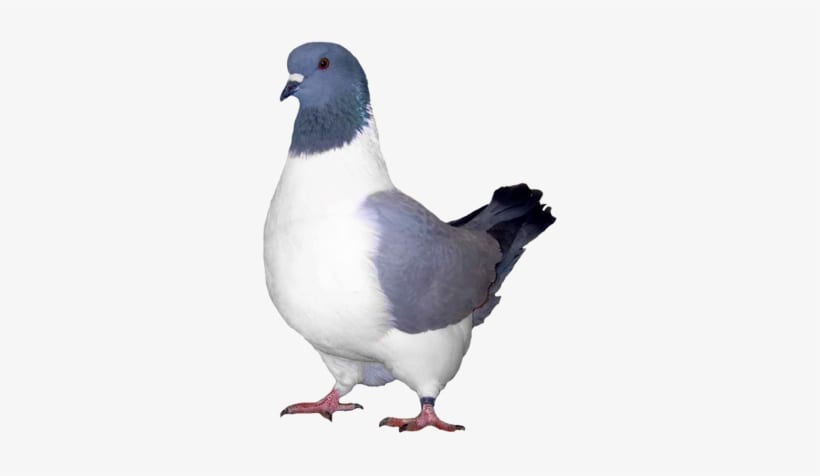
by Pigeon Patrol | Nov 23, 2020 | Bird Deterrent Products, Bird Netting, Pigeon Control, Pigeon Droppings, Pigeon Patrol's Services, Pigeons in the News
Ever heard of ice pigeons? No? keep on reading to find out what they are!
Ice Pigeons
The Ice pigeon is a breed of fancy pigeon developed over many years of selective breeding. Ice pigeons, along with other varieties of domesticated pigeons, are all descendants from the rock pigeon. In 1846, Charles Darwin is known to have crossbred the Ice pigeon in order to ascertain colour patterns.
it is one of the oldest of the German color pigeon breeds and was developed over many years of selective breeding.The breed is actually from the South Germany. And it was first developed in the region from eastern Germany to western Poland, with most early breeding in Saxony and Silesia.
Where Do They Live?
And it was first developed in the region from eastern Germany to western Poland, with most early breeding in Saxony and Silesia. The Ice pigeon and other varieties of domesticated pigeons, all are descendants from the wild or feral rock pigeon.
Appearance
This pigeon is an average sized bird which is named and known for it’s ‘ice-blue’ coloration. It’s head is slightly oblong, and have smooth head.
It has several varieties, which are differing in the type and color of their wing pattern. But the basic color of these birds is a pale grey.
Eyes of these birds are of different color depending on the variety. The black barred and checked version has orange to yellow orange colored eyes. And all other varieties have black eyes.
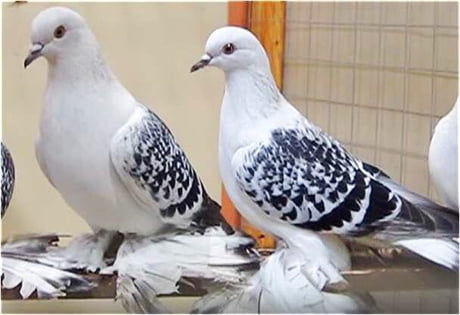
| Ice Pigeon | Breed Profile |
| Breed Name |
Ice |
| Other Name |
Polish: Lazurek; German: Eistaube |
| Breed Purpose |
Exhibition, ornamental, pets |
| Special Notes |
Beautiful, calm and gentle in nature, good for ornamental purpose, good for exhibition, good for raising as pets |
| Breed Class |
Small to medium |
| Climate Tolerance |
All climates |
| Flying Ability |
Average |
| As Pets |
Good |
| Color |
Many |
| Rarity |
Common |
About Pigeon Patrol:
Pigeon Patrol Products & Services is the leading manufacturer and distributor of bird deterrent (control) products in Canada. Pigeon Patrol products have solved pest bird problems in industrial, commercial, and residential settings since 2000, by using safe and humane bird deterrents with only bird and animal friendly solutions. At Pigeon Patrol, we manufacture and offer a variety of bird deterrents, ranging from Ultra-flex Bird Spikes with UV protection, Bird Netting, 4-S Gel and the best Ultrasonic and audible sound devices on the market today.
Contact us at 1- 877– 4– NO-BIRD, (604) 585-9279 or visit our website at www.pigeonpatrol.ca
Pigeon / Pigeon Patrol / Pigeons Roosting / Vancouver Pigeon Patrol / Bird Control / Surrey Pigeon Control / Pest / Vancouver Pigeon Blog / Birds Inside Home / Pigeons in the cities / Ice Pigeons
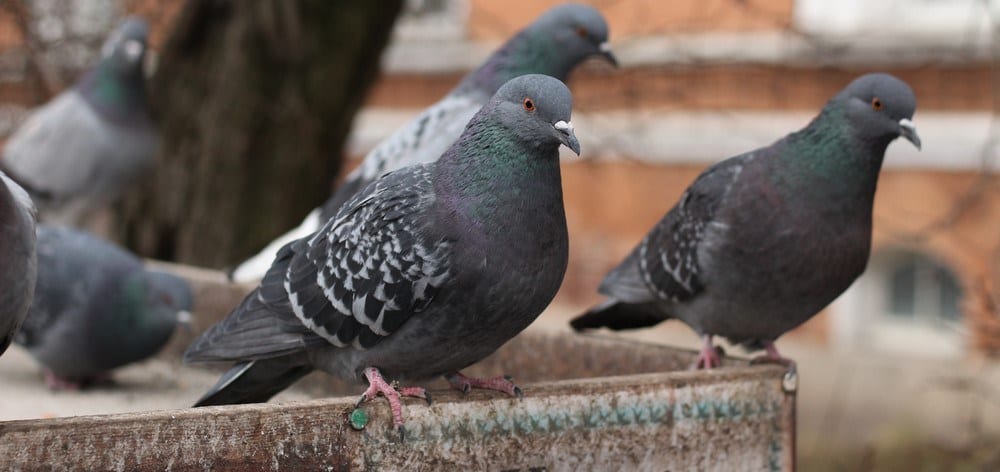
by Pigeon Patrol | Nov 23, 2020 | Bird Netting, Pigeon Control, Pigeon Patrol's Services, Pigeon Spikes, Pigeons in the News
Ever thought about why there are so many pigeons in your city? I have, I always notice a flock of pigeons hanging out on posts and rooftops and individually roaming the streets. But why are there so many? Keep on reading to find out! It may surprise you.
Pigeons In The City
Some people feed pigeons bread crumbs or keep them as pets in rooftop coops. Others see the animals as pests, carriers of disease or simply “rats with wings.” But whatever you think about these birds, there’s one fact no one will argue: Pigeons are everywhere.
Have you ever wondered how one kind of bird managed to take over urban areas as far apart as Washington; London, England; Mumbai, India; and Melbourne, Australia? Or why it is that pigeons are so plentiful in cities and not eagles, turkeys, hummingbirds or vultures?
Well, the first thing you need to know about pigeons is that they’re actually doves. Or doves are actually pigeons. Scientifically, there’s no difference between the two.
“In some languages, there isn’t even a separate word for ‘pigeon,’ ” said Colin Jerolmack, a scientist at New York University who studies human societies.
There are still pigeons living in the wild today. They evolved on the shores of North Africa and the Mediterranean Sea, where they make their homes on rocky ledges and cliffs. And it was this natural love for hard surfaces that made them a perfect fit in urban areas.
“They actually really like concrete, marble and stone, so they prefer to live and build nests not in the trees and shrubs and grass, but alongside buildings,” said Jerolmack, who wrote a book called “The Global Pigeon.”
But perhaps the biggest reason you’ll find pigeons in cities around the world is because humans brought them there.
At least as long as 5,000 years ago, the people of an ancient Middle Eastern civilization known as Mesopotamia started putting out houses for these birds. As the birds became more tame, people began breeding them for food in areas where other wild animals had become scarce.
Later, people learned that they could also use pigeons to carry written messages over long distances, thanks to the birds’ homing instinct.
“You can take a street pigeon in D.C. and drive it down to North Carolina and release it, and, more often than not, it’ll find its way home,” Jerolmack said.
As you can see, pigeons can be quite useful. It’s been only in the past 80 to 100 years that people started disliking the birds, Jerolmack said. And much of the dislike comes from misunderstanding.
For example, there’s really no solid evidence that pigeons pass diseases on to people. And once you get to know them, you might change the way you think.
Did you know that pigeons mate for life, for instance? Or that once their chicks hatch, both parents take turns feeding their young a liquid produced in their digestive tract called “crop milk?”
Anyway, humans have only themselves to blame for the pigeons cooing on every corner.
“We bred them and domesticated them, and kept them in cities as we developed cities,” Jerolmack said. “So they’ve always been here, from the beginning.”
There are still pigeons living in the wild today. They evolved on the shores of North Africa and the Mediterranean Sea, where they make their homes on rocky ledges and cliffs. And it was this natural love for hard surfaces that made them a perfect fit in urban areas.
“They actually really like concrete, marble and stone, so they prefer to live and build nests not in the trees and shrubs and grass, but alongside buildings,” said Jerolmack, who wrote a book called “The Global Pigeon.”
But perhaps the biggest reason you’ll find pigeons in cities around the world is because humans brought them there.
At least as long as 5,000 years ago, the people of an ancient Middle Eastern civilization known as Mesopotamia started putting out houses for these birds. As the birds became more tame, people began breeding them for food in areas where other wild animals had become scarce.
Later, people learned that they could also use pigeons to carry written messages over long distances, thanks to the birds’ homing instinct.
“You can take a street pigeon in D.C. and drive it down to North Carolina and release it, and, more often than not, it’ll find its way home,” Jerolmack said.
As you can see, pigeons can be quite useful. It’s been only in the past 80 to 100 years that people started disliking the birds, Jerolmack said. And much of the dislike comes from misunderstanding.
For example, there’s really no solid evidence that pigeons pass diseases on to people. And once you get to know them, you might change the way you think.
Did you know that pigeons mate for life, for instance? Or that once their chicks hatch, both parents take turns feeding their young a liquid produced in their digestive tract called “crop milk?”
Anyway, humans have only themselves to blame for the pigeons cooing on every corner.
“We bred them and domesticated them, and kept them in cities as we developed cities,” Jerolmack said. “So they’ve always been here, from the beginning.” Source

About Pigeon Patrol:
Pigeon Patrol Products & Services is the leading manufacturer and distributor of bird deterrent (control) products in Canada. Pigeon Patrol products have solved pest bird problems in industrial, commercial, and residential settings since 2000, by using safe and humane bird deterrents with only bird and animal friendly solutions. At Pigeon Patrol, we manufacture and offer a variety of bird deterrents, ranging from Ultra-flex Bird Spikes with UV protection, Bird Netting, 4-S Gel and the best Ultrasonic and audible sound devices on the market today.
Contact us at 1- 877– 4– NO-BIRD, (604) 585-9279 or visit our website at www.pigeonpatrol.ca
Pigeon / Pigeon Patrol / Pigeons Roosting / Vancouver Pigeon Patrol / Bird Control / Surrey Pigeon Control / Pest / Vancouver Pigeon Blog / Birds Inside Home / Pigeons in the cities
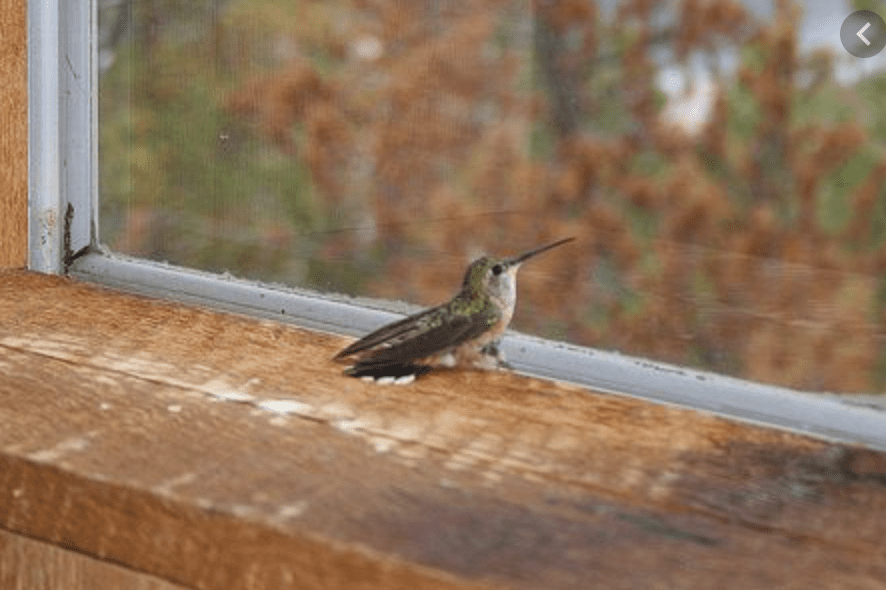
by Pigeon Patrol | Nov 23, 2020 | Bird Netting, Pigeon Control, Pigeon Droppings, Pigeon Patrol's Services, Pigeon Spikes
Outdoor spaces just aren’t the same without colorful, chirping birds that flutter and dance before our eyes. Unfortunately, birds have a troublesome habit of getting into indoor spaces that aren’t made for wild animals. The problem is especially acute during the cool season. If you’re dealing with bird problems in the home, you need to know what causes indoor bird infestations and what you can do about them.
Why Do Birds Come Inside?
Birds come inside for many different reasons. In some cases, indoor spaces mimic birds’ natural habitats or provide suitable, sheltered locations for the construction of nests or perches.
In other cases, carnivorous birds follow small animals like mice inside. With a steady supply of prey, they find it easier to remain inside than brave the uncertain outside world.
Even birds that don’t hunt indoor pests may be drawn to easily accessible food sources, including grains and seeds, inside the home.
How Do Birds Get Inside Your Home?
The chimney isn’t the only way that a bird can enter your house; exhaust vents and small holes in your roof are also prime targets. If you didn’t actually see the stray bird come out of your fireplace, check your attic to see if there are more of them living on your property. 3. Put screens on your windows and doors
Birds tend to spend more time indoors during the cool season. Some of the most common pest species inside Arizona homes include:
- House sparrows that can easily penetrate small holes and vents
- Woodpeckers that can easily break apart wooden structural elements to create nests or food sources
- Birds of prey that use sheltered areas as perches
How to Handle Birds Inside the Home Source
It can be overwhelming and even frightening to deal with birds inside the home. Fortunately, there are a number of proven strategies that can help mitigate the problem:
- Cut off carnivorous birds’ food sources by controlling indoor pests like mice and rats
- Install ventilation screens and other barriers to entry
- Patch holes and other “weak points” in your home’s siding, roof, foundation line and garage
- Put out a bird feeder to discourage food-seeking behavior inside the home
- Call a professional to handle stubborn infestations
Protect Your Home Against Birds in Vancouver B.C Call Pigeon Patrol
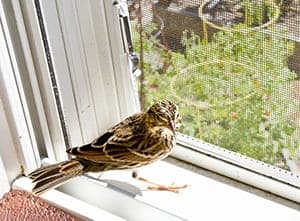
About Pigeon Patrol:
Pigeon Patrol Products & Services is the leading manufacturer and distributor of bird deterrent (control) products in Canada. Pigeon Patrol products have solved pest bird problems in industrial, commercial, and residential settings since 2000, by using safe and humane bird deterrents with only bird and animal friendly solutions. At Pigeon Patrol, we manufacture and offer a variety of bird deterrents, ranging from Ultra-flex Bird Spikes with UV protection, Bird Netting, 4-S Gel and the best Ultrasonic and audible sound devices on the market today.
Contact us at 1- 877– 4– NO-BIRD, (604) 585-9279 or visit our website at www.pigeonpatrol.ca
Pigeon / Pigeon Patrol / Pigeons Roosting / Vancouver Pigeon Patrol / Bird Control / Surrey Pigeon Control / Pest / Vancouver Pigeon Blog / Birds Inside Home
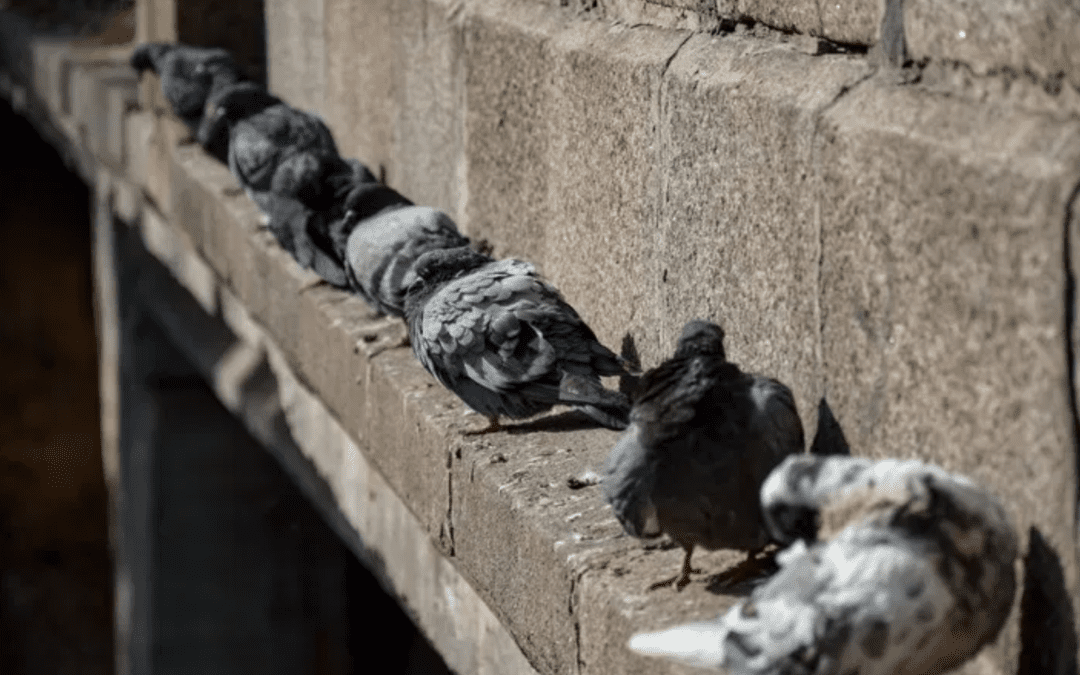
by Pigeon Patrol | Nov 23, 2020 | Bird Deterrent Products, Bird Netting, Pigeon Control, Pigeon Droppings, Pigeon Patrol's Services, Pigeon Spikes
Do you have pigeons roosting at your property? Not sure if they cause any harm or if you should get rid of them? Keep on reading to find out what pigeons may do to your property!
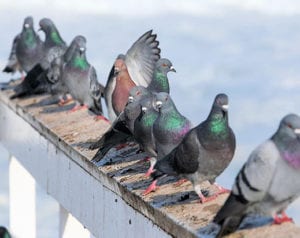
Pigeons may seem harmless, but these pest birds cause millions of dollars in damage every year to buildings, ventilation systems, machinery, statues, roofs, and much more. Bird droppings and nesting materials left by pigeons pose physical problems and health hazards that can become very serious if not corrected quickly making prompt and effective professional bird control is often essential.
Pigeons Roosting
Pigeons find our window ledges, rooftops, bridges, and warehouses to be ideal substitutes for the natural ledges in cliff sides that they have always used as roosting, nesting, and sheltering sites. When flocks grow too large and become a nuisance, killing the birds is often the first plan of action.
Potential Health Hazards:
There are many health risks associated with pigeons and their droppings. The bacteria, fungi, and ectoparasites that they and their droppings harbor are numerous. The four most common ways disease is passed by bird to human are: inhalation of fecal dust, food and water contaminated with bird feces, direct contact with feces, and parasitic transfer.
Pigeon droppings can expose humans to many diseases, including salmonella, Newcastle disease, candidiasis, encephalitis, orthosis, and toxoplasmosis. In addition, they can also carry cryptococcosis, and coccidiodomycosis, which cause meningitis. The droppings may also harbor growth of fungus, which causes histoplasmosis. Fleas, lice, mites, and other pests often live on these birds, hitching a ride to where ever they want to jump off. Pigeons may also attract other pests, such as rats, which feed on dead pigeons and food that well-intentioned bird lovers may scatter for them.
In addition to disease, bird droppings are known for triggering 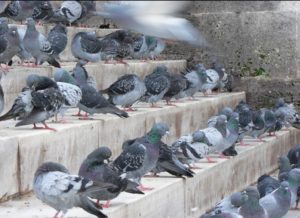 people to slip and fall, which makes it especially important to rid the birds from highly trafficked areas. Source
people to slip and fall, which makes it especially important to rid the birds from highly trafficked areas. Source
Damage Caused by Pigeons:
These are messy birds, leaving droppings everywhere they go, particularly near their roost sites. Pigeon droppings are not just gross, they are also full of uric acid which makes them extremely corrosive. The droppings are the direct cause of millions of dollars in damage to buildings and other structures. Particularly vulnerable are painted surfaces, awnings, signs, and other similar surfaces. A tragic example of the corrosiveness of pigeon droppings is the Minnesota bridge accident in 2007, which was found to be the direct result of bird droppings eating away at the metal bridge supports until they weakened.
In addition to the damage cause by their acidic droppings, pigeon nests can also cause damage. Pest birds will often build nests in gutters or on roof corners blocking essential drainage systems. Every year several warehouses experience roof damage, and even collapse, when drainage systems have been blocked and standing water rises just six inches. Bird nests can also block ventilation systems, which not only prevents exhaust of potentially harmful gases, but also has the potential to spread diseases. Fire is also a potential hazard. Nesting materials are usually flammable, consisting of twigs, straw, grasses and dried droppings. When pest birds build their nests inside electric signs or other machinery there is a great risk of fire.
Pigeons are creatures of habit and highly social. Once they have found a cozy spot the will return again and again, bringing along more of their pigeon pals. Prolific breeders, pigeons can hatch several broods a year, sometimes even laying a new clutch before the previous have even hatched. Often our buildings and structures have architectural features such as drain spouts and eaves that make perfect nesting spots for these birds. Pigeons are comfortable around humans and they’re hard to scare away or deter. Once a flock of stubborn unwanted pigeons have set up shop in/on your building, it can be stubbornly resistant to removal, often requiring the services of a pest control or animal control professional. As is true of many pests that invade our homes and businesses, the first step to controlling feral pigeons is to remove their food source.
Tips to deter pigeons:
- Don’t feed the pigeons.
- Screen drains and gutters to make your property less attractive to pigeons.
- Encourage children to pick up spilled food – and teach them NOT to feed pigeons
- Keep areas around trash bins and outdoor dining areas clean
- Eliminate water sources such as bird baths, over-watered lawns, or kiddy pools.
If you need help to prevent or eliminate pesky problem pigeons, please contact us!
Hope you learned more about why you should take action when pigeons are roosting on your property
About Pigeon Patrol:
Pigeon Patrol Products & Services is the leading manufacturer and distributor of bird deterrent (control) products in Canada. Pigeon Patrol products have solved pest bird problems in industrial, commercial, and residential settings since 2000, by using safe and humane bird deterrents with only bird and animal friendly solutions. At Pigeon Patrol, we manufacture and offer a variety of bird deterrents, ranging from Ultra-flex Bird Spikes with UV protection, Bird Netting, 4-S Gel and the best Ultrasonic and audible sound devices on the market today.
Contact us at 1- 877– 4– NO-BIRD, (604) 585-9279 or visit our website at www.pigeonpatrol.ca
Pigeon / Pigeon Patrol / Pigeons Roosting / Vancouver Pigeon Patrol / Bird Control / Surrey Pigeon Control / Pest / Vancouver Pigeon Blog /
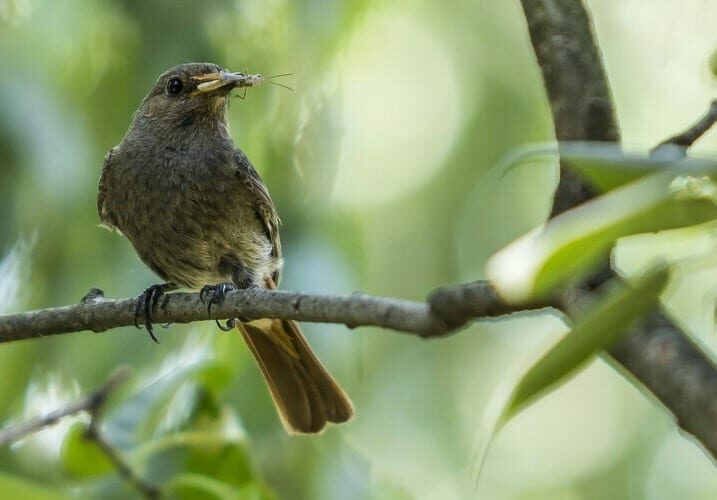
by Pigeon Patrol | Nov 15, 2020 | Bird Deterrent Products, Bird Netting, Bird Spikes
Wanna know how to keep pest birds away from your garden? Well you’ve come to the right place!
It takes work to till, plant and weed a garden. But the results are worth it—flowers, fruits and vegetables you can proudly share with family and friends. The problem is birds. They like your garden too.
Pest Birds Can Destroy Gardens
Without effective bird controls, pest birds like sparrows, swallows, pigeons and crows can wreak havoc on your garden. Songbirds will show no mercy to your broccoli, corn, green peas, snap peas, apples, apricots, blackberries, blueberries, cherries, currants, grapes, peaches, pears, plums, raspberries and strawberries. You’ll know you have a problem if patches of young seedlings completely disappear, or the tops of your young plants are chewed off, or if you notice bites taken out of the berries as they ripen.
Mocking birds, orioles and thrashers, for example, will eat your oranges. Bluebirds, finches, robins and waxwings love to feast on grapes. Starlings will go after your cherries. Regardless of the fruit you’re growing, there’s a bird that will “beat you to the picking.” Birds also won’t hesitate to crater your lawn while they dig for bugs. In times of drought, birds will eat many different fruits and vegetables, including tomatoes and melons.
Lethal Means of Bird Control Are Often Illegal
Some homeowners are tempted to resort to lethal bird control measures. Poisons (avicides) should not be used, since they can be ingested by pets and pose additional hazards to adults and children. These lethal substances are also tightly controlled by the government, and many species of birds are protected, so their use is highly restricted. The use of firearms, even pellet guns, should also be avoided, since they pose harm and possible injury to neighbours, pets and property. Trapping birds is one option, but this method won’t stop other birds from invading your garden. If your garden is attractive for roosting and nesting, they’ll just keep coming.
The hard truth is that unless you implement some effective bird control measures, you’re just growing fruits and vegetables for the birds. To save your garden, here are some inexpensive and humane strategies the bird control experts at Absolute Bird Control recommend:
Make Your Garden Less Attractive to Pest Birds
To deter pest birds from your garden, start by removing their easy access to food and water—including pools of standing water after rains or sprinkler use. Convince your family (especially kids and grandma/grandpa) to stop feeding any birds. These early “scouts” will bring flocks to your garden. So make sure trash containers are tightly closed, and clean any food scraps around tables, benches and chairs. Finally, deny birds access to nesting and roosting sites around your property by sealing all openings to eaves, lofts, steeples and vents.
Another Way To Keep Pest Birds Away: Create a Visual Distraction Zone for Pest Birds
To keep pest birds from your garden, create a visual distraction zone around it. Absolute Bird Control offers a number of economical products that will harmlessly alarm or distract pest birds. Here are five you should consider:
- Flash Tape. This tape comes in 100-ft rolls and is made of iridescent foil that’s easily cut into short strips. Affixed to high visibility areas of your garden, the strips snap in the wind and reflect sunlight to make birds too nervous to stay.
- Bird Scare Diverters. These teardrop-shaped deterrents intimidate pest birds with a predator eye on a reflective surface. A swivel attachment allows the diverter to rotate 360° for added effectiveness. Attach to fences, trees and patio covers.
- Bird Scare Balloons. Covered with lifelike reflective predator eyes and markings, these balloons are 16-inches in diameter (about he size of a standard beach ball). Pest birds take one look at those big bright eyes and think they’re about to be attacked by a giant predator. Made of UV-resistant and weather-resistant vinyl. Attach to fences, trees and patio covers.
- Hawk Decoys. These realistic-looking decoys stand about 17 inches tall to convince pest birds that a real hawk is standing by ready to strike. Made of heavy duty plastic to ensure its “live” appearance, the decoys can be placed in any high visibility area of your garden. Simply move the decoy from time to time to keep pest birds “on their toes.” Source
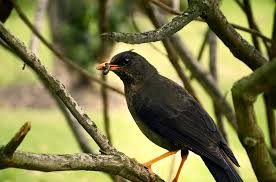
About Pigeon Patrol:
Pigeon Patrol Products & Services is the leading manufacturer and distributor of bird deterrent (control) products in Canada. Pigeon Patrol products have solved pest bird problems in industrial, commercial, and residential settings since 2000, by using safe and humane bird deterrents with only bird and animal friendly solutions. At Pigeon Patrol, we manufacture and offer a variety of bird deterrents, ranging from Ultra-flex Bird Spikes with UV protection, Bird Netting, 4-S Gel and the best Ultrasonic and audible sound devices on the market today.
Contact us at 1- 877– 4– NO-BIRD, (604) 585-9279 or visit our website at www.pigeonpatrol.ca
Bird Gone, Pigeon Gone, Seagull Gone, Pigeon problems, 1-877-4NO-BIRD, 4-S Gel, Bird Control, Pigeon Control, bird repellent,, sonic bird repellent, stainless steel , bird spikes Vancouver, Ultra Sonic Bird Control, Bird Netting, stop aggressive pet birds Canada bird deterrents, Pigeon Pests, B Gone Pigeon, Pigeon Patrol, pest controller, pest control operator, pest control technician, Pigeon Control Products, humane pigeon, pigeon deterrents, pigeon traps, Pigeon repellents, stop aggressive pet birds Sound & Laser Deterrents, wildlife control, raccoon, skunk, squirrel deterrent, De-Fence Spikes, Dragons Den, Canada bird spikes, Canada pigeon, pigeon control, pigeon patrol, pigeon. destroy pigeons, crow, starling, Pigeon Habitat, Pigeon identifications, pigeon myths, stop aggressive birds, stop aggressive pet birds, problems with pest birds, Keep away pest birds
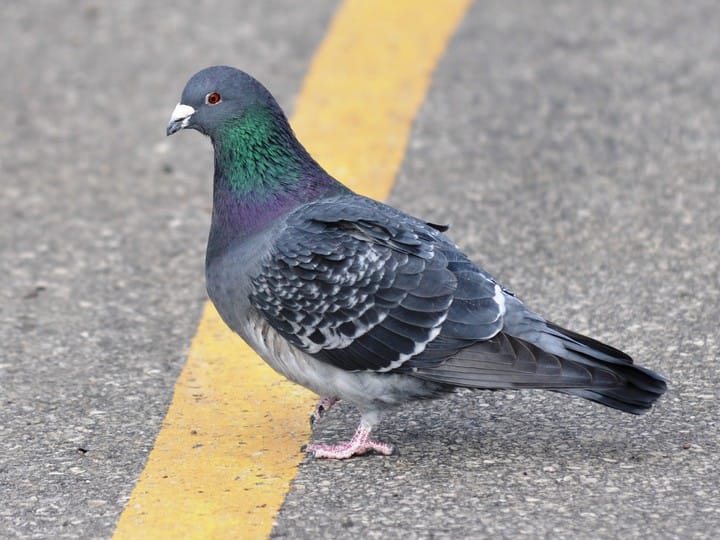
by Pigeon Patrol | Nov 15, 2020 | Animal Deterrent Products, Bird Deterrent Products, Bird Netting, Bird Spikes
Do you wanna know what the problems are with pest birds? then keep on reading!
| Pest Bird Problems – Problems Caused by Pest Birds
Birds problems can cause damage to buildings and agriculture environments. Many bird problems are due to poor planning and /or design. Nimby Bird Control Solutions has a team of experts who first study the bird problems and develop a plan of action to address the particular bird problem faced by each client.
Nimby Bird Control Solutions is committed to environmentally sound methods of bird control. This includes a number of bird control techniques including netting, spikes, electric shock and other bird deterrents. Our methods to address bird problems first begin with a thorough examination and understanding of each bird problem situation. |
|
| Types of Bird Problems
Pigeon Nesting Bird Problems
Nesting can cause fire hazards and extensive damage to roofs, eaves, structures and machinery. Nesting around building ventilation systems will cause them to clog and work inefficiently. Birds nesting can introduce bacteria and viruses into buildings. Spores, parasites, fleas and ticks can become serious health hazards in affected buildings. Nests in chimneys and vents can block exhausting of moisture and carbon monoxide. This can cause build up of mold and carbon monoxide causing health hazards.
Pigeon droppings Bird Problems
Bird Droppings are not just unsightly. They contain allergens and health hazards. They are also highly corrosive and harmful to buildings, machinery. Bird droppings can lead to clogging of the ventilation ducts and obstruction of drainage systems. Damage to equipment and machinery, buildings and roofs can be very expensive to repair. Unpleasant odors can permeate through ducts and ventilation systems. Bird droppings and feces, when inhaled, can cause an incurable disease called histoplasmosis which is characterized by constant flu-like symptoms. Source
Property damage Bird Problems
Property Damage to roofs, eaves, chimneys and machinery are among some of the issues faced by property managers. Bird droppings contain corrosive matter including uric acid. They are extremely harmful to machinery and equipment and are often the cause of expensive damage to stored items as well. Bird droppings can accumulate and block gutters and result in water damage to roofs and walls.
Appearance issues Bird Problems
Appearance issues Nests, droppings and debris cause appearance problems as well as safety and health concerns. At entrances to buildings, stores and restaurants they can be unsightly and a reason for drop in traffic and sales. Depending on their locations, bird droppings in high traffic areas can cause safety concerns. Around paths and walkways, and at entrances to stores and buildings, bird droppings and bird feces are slippery and unsafe, can spread bacteria and health risks.
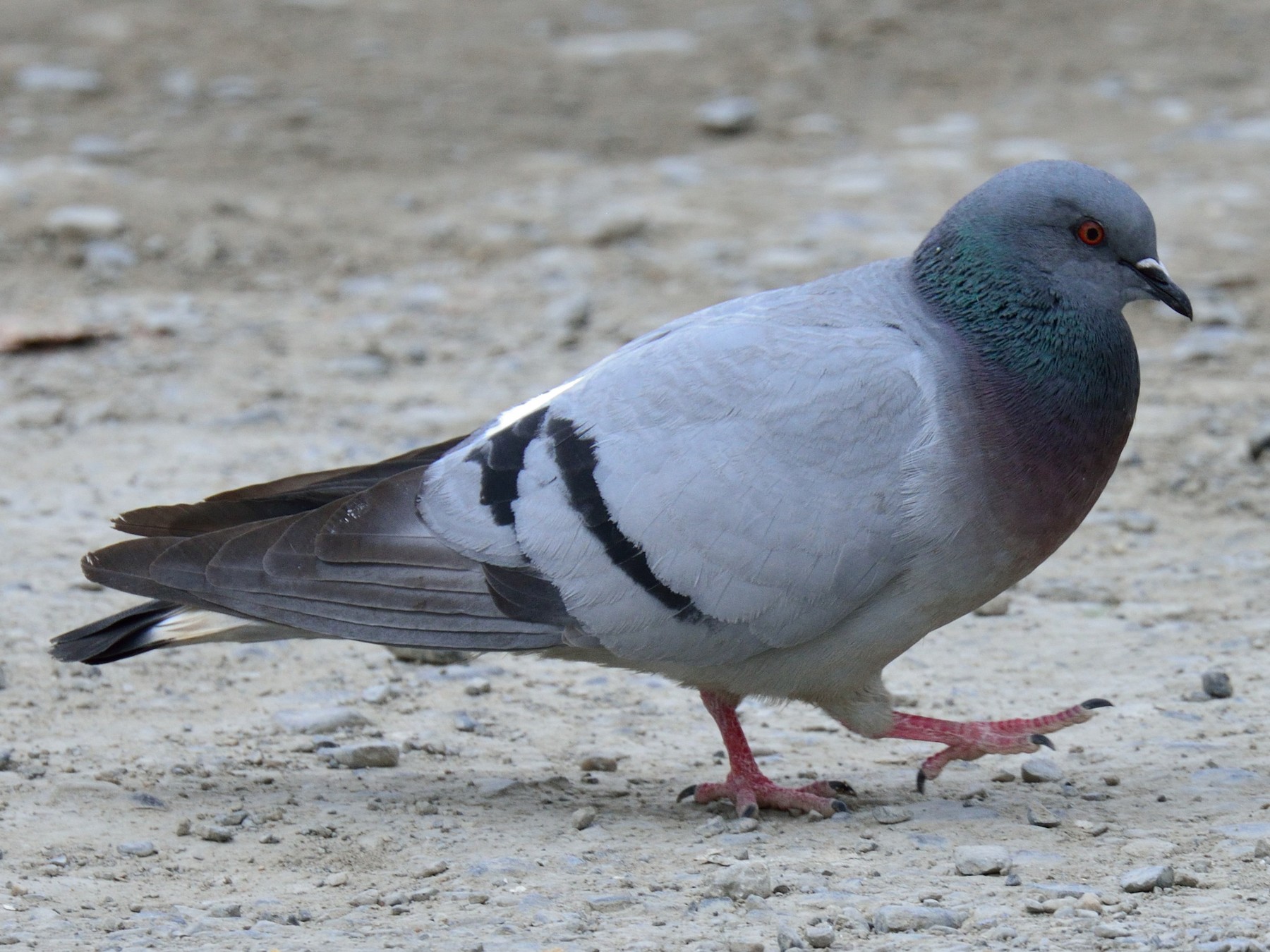
Safety hazards
Safety Hazards are frequently less understood. Birds carry allergens, parasites, bacteria and other health risks to humans. Histoplasmosis, encephalitis and other infectious diseases are spread by birds. Birds nesting around air-conditioning equipment can spread these contaminants throughout buildings and cause a phenomenon called sick building. Birds introduce parasites, fleas and ticks in the environment around their nesting areas and building ventilation system. Air circulation can quickly spread odor and contaminants throughout the building.
Food Contamination Bird Problems
In warehouses, food manufacturing plants, grain silos, storage facilities. Grocery stores with open displays, exposed food shelves and other such facilities require special attention. Birds often find ways to nest and breed around such buildings. Contaminated food, stored items may have to be destroyed and extensive expenses incurred for cleaning and sanitation.
Bird Problems in airport hangars and small twin engine planes on tarmac
Aircraft Hazards – there are a number of bird problems besides bird strikes that are faced by municipal airports. Birds find nesting areas and form colonies around aircraft hangars, maintenance buildings. They can cause slippery hangar floors due to their droppings and thus jeopardize people’s safety. Birds will also lead to unhealthy work environments, foul parts prior to installation, cause hazardous situations when birds inhabit aircraft mechanisms. Bird droppings are extremely corrosive and cause expensive damage to the paint on aircraft. Birds also nest or loaf around airport jetways and loading bridges. Nimby Bird Control Solutions has effective bird control solutions designed especially for bird problems at aircraft hangars and airports.
Birds in agricultural fields Bird Problems
Agricultural Damage Bird Problems have a direct impact on the economics of agriculture. Birds feed on seeds or seedlings, damage or destroy ripened crops or pass bacteria on the crops possibly spreading disease or harmful bacteria. The birds may also eat or defecate on stored food. In small numbers, these bird problems are manageable. Left unchecked, they can have a significant adverse impact on farming operations, fish farms, orchards and vegetable farms. In recent times cormorants have become a serious concern in the upper great lakes region. |
About Pigeon Patrol:
Pigeon Patrol Products & Services is the leading manufacturer and distributor of bird deterrent (control) products in Canada. Pigeon Patrol products have solved pest bird problems in industrial, commercial, and residential settings since 2000, by using safe and humane bird deterrents with only bird and animal friendly solutions. At Pigeon Patrol, we manufacture and offer a variety of bird deterrents, ranging from Ultra-flex Bird Spikes with UV protection, Bird Netting, 4-S Gel and the best Ultrasonic and audible sound devices on the market today.
Contact us at 1- 877– 4– NO-BIRD, (604) 585-9279 or visit our website at www.pigeonpatrol.ca
Bird Gone, Pigeon Gone, Seagull Gone, Pigeon problems, 1-877-4NO-BIRD, 4-S Gel, Bird Control, Pigeon Control, bird repellent,, sonic bird repellent, stainless steel , bird spikes Vancouver, Ultra Sonic Bird Control, Bird Netting, stop aggressive pet birds Canada bird deterrents, Pigeon Pests, B Gone Pigeon, Pigeon Patrol, pest controller, pest control operator, pest control technician, Pigeon Control Products, humane pigeon, pigeon deterrents, pigeon traps, Pigeon repellents, stop aggressive pet birds Sound & Laser Deterrents, wildlife control, raccoon, skunk, squirrel deterrent, De-Fence Spikes, Dragons Den, Canada bird spikes, Canada pigeon, pigeon control, pigeon patrol, pigeon. destroy pigeons, crow, starling, Pigeon Habitat, Pigeon identifications, pigeon myths, stop aggressive birds, stop aggressive pet birds, problems with pest birds
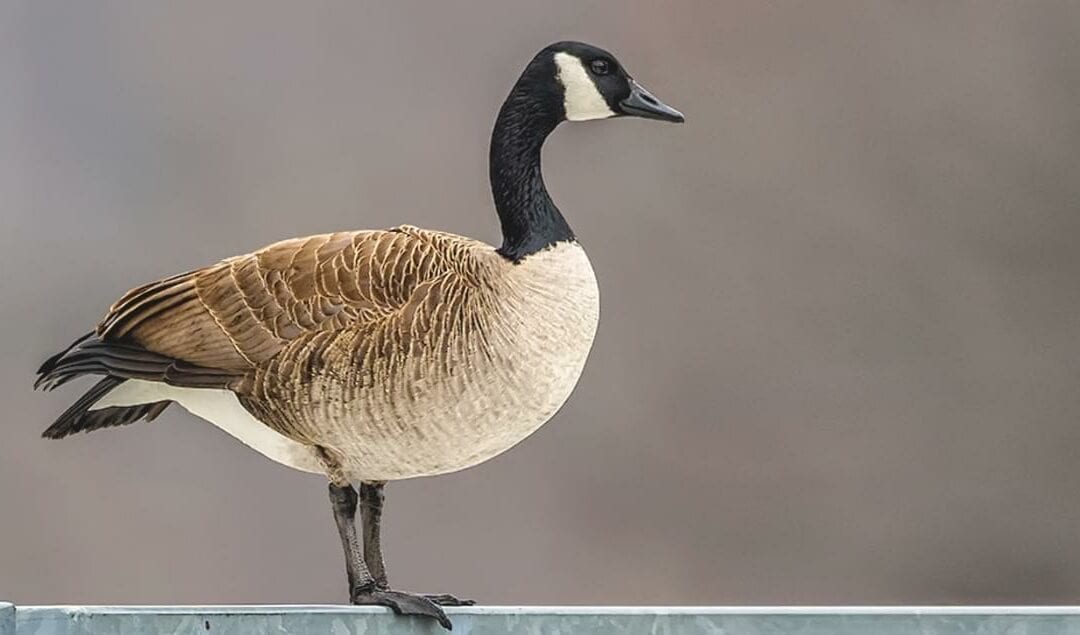
by Pigeon Patrol | Nov 15, 2020 | Animal Deterrent Products, Bird Deterrent Products, Bird Law, Bird Netting, Bird Spikes, Columbidae, Doves, history of pigeons, Pigeon Control, Pigeon Droppings
Looking for more information about which birds are considered pests? Read on to learn more!
The Birds That Are Pests
There are six types of birds found in Canada can be classified as nuisance pests, which are the house sparrows, starlings, pigeons, woodpeckers, gulls, and Canada geese
The house sparrow is a bird of the sparrow family Passeridae, found in most parts of the world. It is a small bird that has a typical length of 16 cm and a mass of 24–39.5 g. Females and young birds are coloured pale brown and grey, and males have brighter black, white, and brown markings
Starlings are small to medium-sized passerine birds in the family Sturnidae. The name “Sturnidae” comes from the Latin word for starling, sturnus. Many Asian species, particularly the larger ones, are called mynas, and many African species are known as glossy starlings because of their iridescent plumage
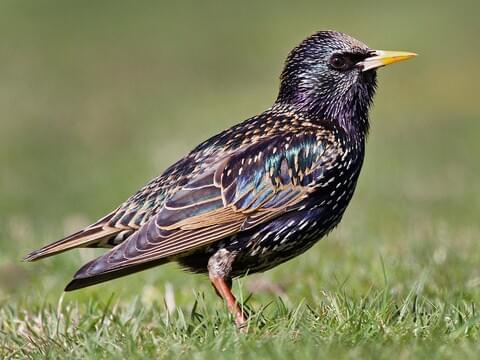
Pigeon
Next on the list is the Pigeon, Also known as the rock dove. Pigeons are known for causing diseases and damage due to their droppings. The droppings trigger human slips and falls as well as accelerating the aging of structures and statues.. Other pests that live on these birds are fleas, lice, mites, ticks and more. Pigeons vary in color but most of them are bluish gray with 2 black bands on the wing and black tip to the tail.
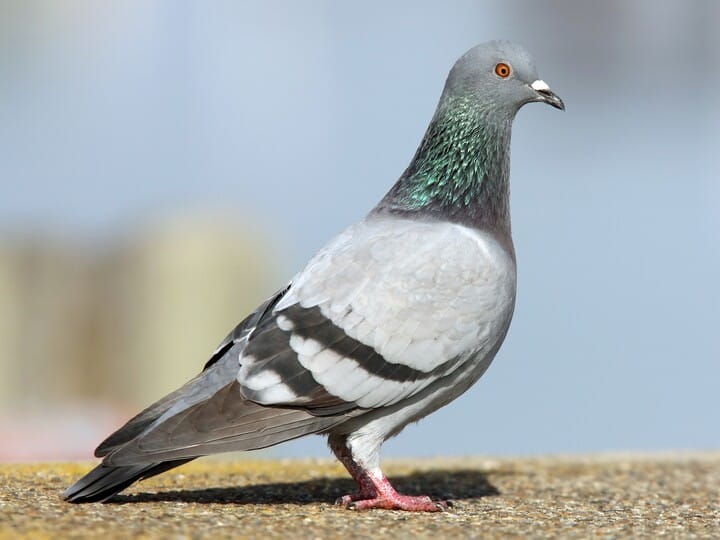 Source
Source
Woodpeckers
Woodpeckers are part of the family Picidae, that also includes the piculets, wrynecks, and sapsuckers. Members of this family are found worldwide, except for Australia, New Guinea, New Zealand, Madagascar, and the extreme polar regions. A woodpecker will attack for many reasons. The attack can be for food, shelter or to attract a mate. The reasons for attack include finding insects for food, often carpenter bees, or for a nest cavity or roosting site, or for other social reasons.
Gulls
Gulls, or colloquially seagulls, are seabirds of the family Laridae in the suborder Lari. They are most closely related to the terns and only distantly related to auks, skimmers and even more distantly to waders
Canada Geese
The Canada goose is a large wild goose species with a black head and neck, white cheeks, white under its chin, and a brown body. It is native to arctic and temperate regions of North America, and its migration occasionally reaches northern Europe
How to identify Birds
Canadian bird pests vary in length, overall size, and colouration. The smallest pest bird species, house sparrows are approximately 14 to 18 cm long with a wingspan of 19 to 25 cm. At the other end of the spectrum, Canada geese boast a wingspan as long as 182 cm and range from 90 to 120 cm in length. Some of the most common bird colourations include shades of grey, white, black, and brown. Pigeons, which rank as arguably the most colourful bird pest, may appear with streaks of light blue, green, lilac, peach, and various other shades.
Signs of an infestation
Birds are not exactly stealthy creatures, and infestations usually become evident with the increased presence of adult birds, the frequent occurrence of chirping and other noises, the sighting of nests, and an increased quantity of droppings in the area.
Birds Removal
Modifying the surrounding environment can aid property owners in ridding buildings of nuisance birds. Netting or spike strips can be strategically positioned to deter or prevent birds from landing and nesting. Noise devices, such as generators that mimic the sounds that natural predators make, work best in agricultural settings, while visual scare tactics are effective in the short term or when paired with other prevention and exclusion techniques. For particularly aggressive birds and those protected by the Migratory Bird Treaty Act, call a fully licensed pest control professional to take care of the problem legally and effectively.
How to prevent Birds from invading
Monitor water accumulating at likely nesting sites, fix any broken or deficient drainage systems, cover outdoor garbage containers tightly, eliminate any notable sources of food.
Habitat, Diet, and Life Cycle
Habitat
Many of the pest birds in Canada are migratory species which fly south when the temperatures approach the freezing point. Many pest birds have a widely distributed population and benefit greatly from the development of cities and the distribution of human populations. Some species construct nests and raise their young in elevated areas, while others nest on the ground. Birds generally prefer to live in the immediate vicinity of a water source but have no trouble flying reasonable distances to collect food. Most species adapt well to various surroundings.
Diet
Pest birds mainly eat fruits, seeds, grains, and insects. Many species live in close proximity to people and often feed on human food like bread, popcorn, peanuts, cake, discarded restaurant fare, and similar items. Much to the dismay of farmers, pest birds frequently target crops and livestock feed, as well. Gulls and Canada geese in particular maintain special dietary preferences. Gulls often feed on fish, rodents, and carrion, while the geese mostly consume plants like cattails, clover, and grass.
Life Cycle
Without exception, birds mate and rear their young in the spring and summer months. On average, pest birds produce one or two broods each year. House sparrows, however, can produce as many as five generations annually. Most birds require an incubation period of two weeks, though the eggs of both Canada geese and gulls require nearly a month of incubation. Newly hatched birds then leave the nest after an average of two to four weeks of preening. Depending on a variety of factors, nuisance birds typically live between 2 and 10 years.
Commonly Asked Questions
How worried should I be about birds?
Pest birds can carry parasites like fleas, mites, and ticks, and transmit diseases to humans and livestock. Pigeon excrement often contains the fungal diseases histoplasmosis and cryptococcosis, which are especially dangerous to people with compromised immune systems.
Many bird species are noisy and can damage buildings and equipment. Not only are pest bird droppings unsightly, they can stick to buildings, potentially eroding the structure.
Pest birds can also create drainage issues and fire hazards by nesting in the small crevices, drains, and gutters of buildings. Many bird species are also aggressive towards humans or native bird populations.
However, dealing with pest birds can be difficult, due to the Migratory Bird Treaty Act, which protects certain species from trapping and relocation practices. Any attempt to remove a pest bird must also comply with the Fish & Wildlife Act.
While netting, spike strips, noise devices, and visual scare tactics may be valid options, often only a professional, licensed pest control service can meet the regulatory standards required when it comes to removing and keeping away pest birds.
About Pigeon Patrol:
Pigeon Patrol Products & Services is the leading manufacturer and distributor of bird deterrent (control) products in Canada. Pigeon Patrol products have solved pest bird problems in industrial, commercial, and residential settings since 2000, by using safe and humane bird deterrents with only bird and animal friendly solutions. At Pigeon Patrol, we manufacture and offer a variety of bird deterrents, ranging from Ultra-flex Bird Spikes with UV protection, Bird Netting, 4-S Gel and the best Ultrasonic and audible sound devices on the market today.
Contact us at 1- 877– 4– NO-BIRD, (604) 585-9279 or visit our website at www.pigeonpatrol.ca
Bird Gone, Pigeon Gone, Seagull Gone, Pigeon problems, 1-877-4NO-BIRD, 4-S Gel, Bird Control, Pigeon Control, bird repellent,, sonic bird repellent, stainless steel , bird spikes Vancouver, Ultra Sonic Bird Control, Bird Netting, stop aggressive pet birds Canada bird deterrents, Pigeon Pests, B Gone Pigeon, Pigeon Patrol, pest controller, pest control operator, pest control technician, Pigeon Control Products, humane pigeon, pigeon deterrents, pigeon traps, Pigeon repellents, stop aggressive pet birds Sound & Laser Deterrents, wildlife control, raccoon, skunk, squirrel deterrent, De-Fence Spikes, Dragons Den, Canada bird spikes, Canada pigeon, pigeon control, pigeon patrol, pigeon. destroy pigeons, crow, starling, Pigeon Habitat, Pigeon identifications, pigeon myths, stop aggressive birds, stop aggressive pet birds
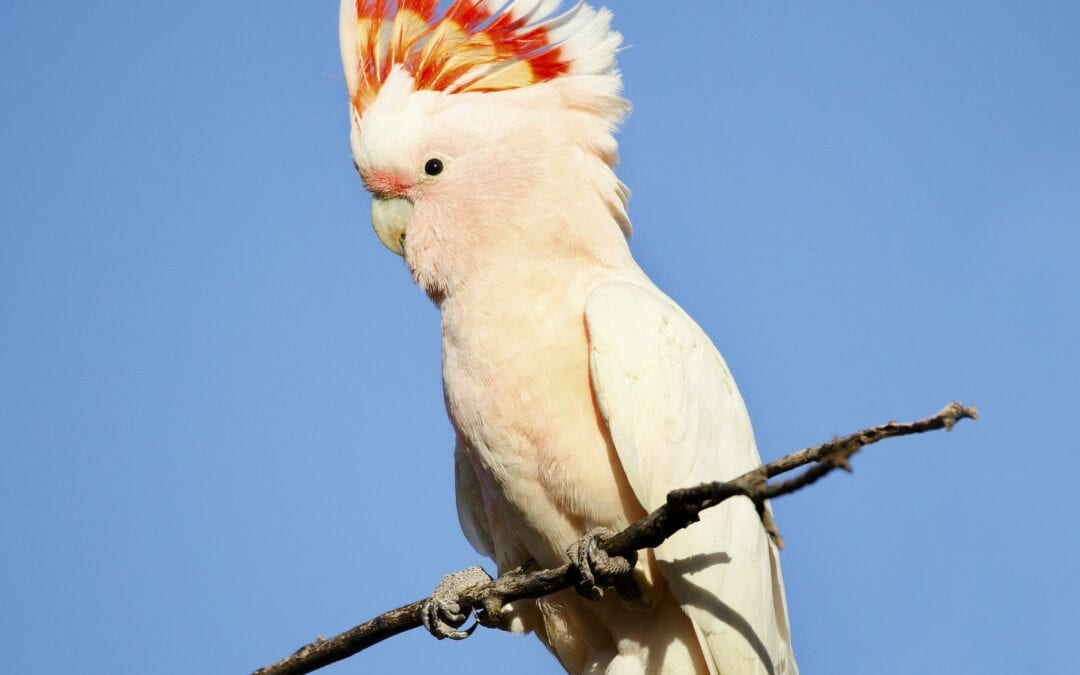
by Pigeon Patrol | Nov 15, 2020 | Animal Deterrent Products, Bird Deterrent Products, Bird Netting, Bird Spikes
Wondering which birds are the smartest of them all? Then keep on reading!
The Smartest Birds
When you think about all of the animals in the world, you quickly realize that birds are, in fact, amongst some of the most intelligent creatures we have on Earth. Although there are more than 10,000 bird species worldwide, only a handful of them have made the list for extremely talented and incredibly intelligent. So who are these super intelligent feathered friends? It’s not easy to really say who is number one or number 2, or to choose the smartest and brightest of them all. But this blog gives you an overview, of what birds have made the top of the list in most bird intelligence studies around the world. So sit back and be amazed how smart some of our feathered friends really are!
Crows

Crows are black birds known for their intelligence and adaptability, and for their loud, harsh “caw.” They also have a reputation for damaging crops; however, their impact may be less than previously thought. The genus Corvus comprises crows, ravens and rooks. These birds are all part of the Corvidae family, which includes jays, magpies and nutcrackers. When it comes to intelligence, Crows should probably be at the top of the list, or close to it. Many scientists think that crows just may be among the most intelligent birds on earth. This intelligent rating is based on their ability to solve problems, make tools as well as consider both future events and other individuals’ states of mind. In addition to Crows making customize tools, they understand causality, can reason, count up to five and remember human faces. In Israel, Wild Hooded Crows actually use bread crumbs to catch fish. In Norway and Sweden they have been seen dragging fishing lines out of water to get the hooked fish. They are second only to humans in intelligence — even smarter than apes in some research tests. And what’s also impressive is that their brain-to-body weight ratio is equal to that of the great apes and cetaceans (whales, dolphins, porpoises) and just slightly lower than in humans.
Kea
Next on the list of smartest birds in the world is the Kea. The kea is a species of large parrot in the family Nestoridae found in the forested and alpine regions of the South Island of New Zealand. About 48 cm long, it is mostly olive-green with a brilliant orange under its wings and has a large, narrow, curved, grey-brown upper beak.The Kea has been enlisted by many as the worlds most intelligent bird among top ten intelligent birds. The Kea is found in New Zealand and it is basically a parrot. This extremely intelligent bird knows how to be very crafty when it comes to finding or stealing food.The troublesome native parrot, is known as the ‘Clown of the Alps’ and can cause havoc with many things (especially cars) and has proved to be as clever as some of the smartest animals on the planet. In some intelligence tests carried out by a Canterbury University masters student, kea outscored gibbons – and anthropoid apes which are part of the primate family.

Jays
Another bird we have up in our list are the Jays.
Blue Jays are one of the smartest birds you’ll see visiting your feeder. As for Blue Jays, there’s still much more to learn and discover, as we don’t know the full extent of their intelligence. However, research so far suggests the Blue Jay is no “birdbrain.” Here are three things we know about Blue Jays that prove their smarts:
Blue Jays can imitate the sounds in their environments, and one thing they mimic is hawk calls. Researchers believe they do this to warn other jays in their family and flock that danger is near. However, Blue Jays don’t shy away from using this ability to their advantage. Some backyard birders have caught jays making this sound to scare off songbirds at the feeder so they can get the feeding station to themselves!
So far, no one has documented Blue Jays using tools in the wild. However, in at least one laboratory setting, Blue Jays were seen ripping pieces of the newspaper lining in their cages, using these strips to help them access out-of-reach food pellets. This suggests when they have the right motivation, Blue Jays have an aptitude for tools. Many Jays avoid eating ants because they taste, well, awful. That bitter taste comes from the ant’s self-defense strategy: When it detects a threat, a gland releases a noxious formic acid that covers the ant’s body. However, Blue Jays found a workaround. They carefully rub the insect on their feathers, a process that birders refer to as anting, to remove the bitter-tasting substance before eating.

Cockatoos
Last on our list of smartest birds are the Cockatoos
A cockatoo is any of the 21 parrot species belonging to the family Cacatuidae, the only family in the superfamily Cacatuoidea. Along with the Psittacoidea and the Strigopoidea, they make up the order Psittaciformes.
Cockatoos are recognizable by the showy crests and curved bills. These extremely social birds have endearing personalities and great speaking abilities. As a part of their extreme intelligence, is their ability to imitate a wide variety of sounds and speech. But more than that, when scientists performed intelligent tests with the captive bred Goffin’s cockatoo they learned they are able to actually resist the temptation of eating a food item put in front of them in order to trade it for a better reward later.
This reaction mirrored a famous experiment in the U.S. 40 years ago when nursery school children were put in a room and given a marshmallow, biscuit or pretzel stick. They could either eat it right away or wait 15 minutes and get an extra treat. On average they are larger than most other parrots.

About Pigeon Patrol:
Pigeon Patrol Products & Services is the leading manufacturer and distributor of bird deterrent (control) products in Canada. Pigeon Patrol products have solved pest bird problems in industrial, commercial, and residential settings since 2000, by using safe and humane bird deterrents with only bird and animal friendly solutions. At Pigeon Patrol, we manufacture and offer a variety of bird deterrents, ranging from Ultra-flex Bird Spikes with UV protection, Bird Netting, 4-S Gel and the best Ultrasonic and audible sound devices on the market today.
Contact us at 1- 877– 4– NO-BIRD, (604) 585-9279 or visit our website at www.pigeonpatrol.ca
Bird Gone, Pigeon Gone, Seagull Gone, Pigeon problems, 1-877-4NO-BIRD, 4-S Gel, Bird Control, Pigeon Control, bird repellent,, sonic bird repellent, stainless steel , bird spikes Vancouver, Ultra Sonic Bird Control, Bird Netting, stop aggressive pet birds Canada bird deterrents, Pigeon Pests, B Gone Pigeon, Pigeon Patrol, pest controller, pest control operator, pest control technician, Pigeon Control Products, humane pigeon, pigeon deterrents, pigeon traps, Pigeon repellents, stop aggressive pet birds Sound & Laser Deterrents, wildlife control, raccoon, skunk, squirrel deterrent, De-Fence Spikes, Dragons Den, Canada bird spikes, Canada pigeon, pigeon control, pigeon patrol, pigeon. destroy pigeons, crow, starling, Pigeon Habitat, Pigeon identifications, pigeon myths, stop aggressive birds, stop aggressive pet birds
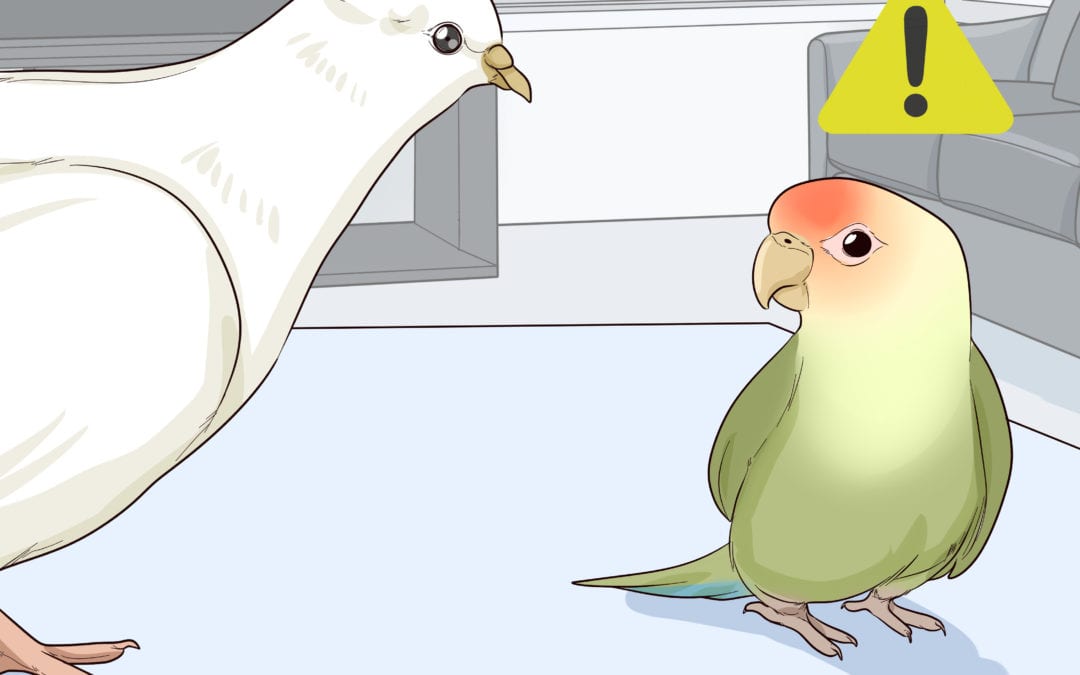
by Pigeon Patrol | Nov 11, 2020 | Bird Deterrent Products, pet bird
There’s no such thing as a mean bird. There are, however, birds that are fearful and those with emotional problems that cause them to want to avoid being handled. When one of these birds finds itself in a situation as a pet, it can be problematic for both bird and owner, possibly leading to bird aggression. Fortunately, you can train your bird to enjoy the time it spends with you.
Why Do Some Pet Birds Have Aggressive Behavior?
The most common causes of aggression in birds are fear or previous traumatic experiences. These can lead to handling problems, bites, and attacks when birds are interacting with their owners and others. Yet, birds are complex and any number of things can lead to aggressive behavior:
Fear often develops in pet birds that were not hand-fed when they were young.
- A lack of proper socialization may lead a bird to be afraid of humans, other birds, or new experiences.
- Some birds become jealous when their owner interacts with other people. This plays on the natural “pair bonding” instinct many bird species have and, in captivity, you may be seen as your bird’s partner.
- If you adopted an older bird, it’s possible that it was mistreated or neglected in some way by its previous owner.
- Some birds become aggressive during their adolescence due to hormone changes. This will typically pass once the bird gets through this stage.
- Protecting their claimed territory, such as the birdcage or feeder, can lead to aggression.
- Birds that are stressed or lack mental stimulation may also act out.
How to Stop Aggressive Behavior
If your pet bird bites you when you try to handle it, you must set aside time each day to work on handling your feathered friend. This doesn’t have to be anything specific; you can incorporate your attempts to reduce your bird’s aggression into normal handling. For instance, you might need to work on bonding with your bird or train it to enjoy petting. You can even teach it how to do fun bird tricks. The point is that the more you work with your bird, the more it will enjoy your company, and the less aggressive it will act.
When working with your pet, a few tips and techniques will help it to learn that handling is safe and fun.
Move to a Neutral Location
If possible, move your bird’s cage to a neutral location during training sessions. Removing a bird from its “territory” can sometimes make it more willing to cooperate with its owner and prevent any territorial aggression.
Don’t Force Contact
If your bird lunges at your fingers when you place your hand near it, try not to jerk away suddenly out of fear. Your swift movements will likely make your bird even more nervous and apprehensive.
Taking it slow and easy is the better method; don’t try to force contact. Try to leave it up to the bird to decide when it’s comfortable enough to step up or accept a treat.
Try Stick Training
Training a bird to step up on a stick or a perch is referred to as “stick training.” It’s the recommended alternative to training a bird that’s not able to be handled at first. It’s a less invasive approach and easier for a bird that is fearful or was traumatized in the past to accept this way of moving without force.
Avoid Yelling
Raising your voice in anger (or pain) will not make your bird understand that it has done something wrong. In fact, it’s more likely to reinforce your bird’s bad behavior as it will love getting such a big reaction out of you. Whatever happens, avoid the temptation to yell at or punish your bird.
Bear Gifts
Offer your bird treats and speak in a soothing voice when you’re trying to handle it. Using treats and praise will help your pet be more willing to interact with you and it’s much more effective than discipline. If every interaction with your bird results in a positive experience, it will likely become more comfortable and open to a closer relationship with you.
Many people try to force interaction in the hope that this will stop the bird from resisting and it will simply give in to being handled. This is referred to as “flooding” and it’s not recommended as a training technique.
Build Trust Through Repetition
With birds, repetition and consistency are keys to training. Make time to work with your bird at least once a day to ensure success. Keep in mind that it sometimes takes a while to build up trust with a bird, so don’t give up!
Don’t Overwork Your Bird
Initially, keep training sessions at a 15-minute maximum. Birds are intelligent and sensitive creatures, and they need to have some fun in order to maintain their mental health and keep from becoming stressed.
Break the Pair Bond
If your bird becomes jealous of your interactions with other people, you will need to enlist the help of family members and visitors. The goal is to better socialize your bird and show it that these people are not a threat to the relationship it has with you.
Try various confidence-building exercises with other people and stay nearby to show your approval. You might, for instance, have visitors offer your bird a treat whenever they enter the house. To reinforce good behavior, they should also praise the bird in a happy, upbeat voice while making eye contact.
Another exercise is to lay out your bird’s food on a towel in front of the bird and have your family pick at it with their fingers, just like a bird does with its beak. If you do this regularly, your bird may want to join in the fun. They can also help you clean the cage or give your bird food or water so it is comfortable with your family’s presence.
Keep a Flexible Routine
Birds need mental stimulation and many enjoy a routine, so regular time for food, play, and other interactions each day is a good idea. However, some birds may react negatively if a routine is too rigid and gets disrupted. source
For example, if you get home from work at a certain time each day and immediately let your bird out for playtime, being late one day could lead the bird to act out. Try to employ some flexibility in your daily routines that involve your bird. It will help the bird better tolerate change and understand that things won’t always happen in a particular order or at a certain time, but it will happen.
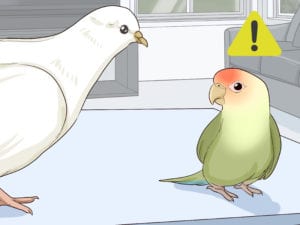
Get Professional Help
If you put in the necessary effort, chances are you will be able to train your pet in a reasonable amount of time. If your bird is so aggressive that you cannot attempt training exercises, the first thing you should do is visit your avian veterinarian to rule out any health concerns. When no physical reasons can explain your pet’s undesirable behavior, contact a certified parrot behavior consultant for an expert opinion on your situation.
& That is how you stop aggressive behavior in pet birds
About Pigeon Patrol:
Pigeon Patrol Products & Services is the leading manufacturer and distributor of bird deterrent (control) products in Canada. Pigeon Patrol products have solved pest bird problems in industrial, commercial, and residential settings since 2000, by using safe and humane bird deterrents with only bird and animal friendly solutions. At Pigeon Patrol, we manufacture and offer a variety of bird deterrents, ranging from Ultra-flex Bird Spikes with UV protection, Bird Netting, 4-S Gel and the best Ultrasonic and audible sound devices on the market today.
Contact us at 1- 877– 4– NO-BIRD, (604) 585-9279 or visit our website at www.pigeonpatrol.ca
Bird Gone, Pigeon Gone, Seagull Gone, Pigeon problems, 1-877-4NO-BIRD, 4-S Gel, Bird Control, Pigeon Control, bird repellent,, sonic bird repellent, stainless steel , bird spikes Vancouver, Ultra Sonic Bird Control, Bird Netting, stop aggressive pet birds Canada bird deterrents, Pigeon Pests, B Gone Pigeon, Pigeon Patrol, pest controller, pest control operator, pest control technician, Pigeon Control Products, humane pigeon, pigeon deterrents, pigeon traps, Pigeon repellents, stop aggressive pet birds Sound & Laser Deterrents, wildlife control, raccoon, skunk, squirrel deterrent, De-Fence Spikes, Dragons Den, Canada bird spikes, Canada pigeon, pigeon control, pigeon patrol, pigeon. destroy pigeons, crow, starling, Pigeon Habitat, Pigeon identifications, pigeon myths, stop aggressive birds, stop aggressive pet birds
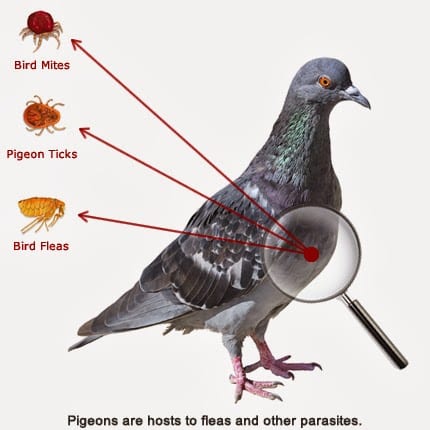
by Pigeon Patrol | Nov 5, 2020 | Animal Deterrent Products, Bird Deterrent Products, Bird Netting, Bird Spike, Bird Spikes, Columbidae, Doves, Pigeon Droppings, Pigeon Patrol's Services, Pigeon Spikes
Are There Any Myths About The Pigeon? Yes.
If you want to find out what the myths are about the pigeon, then keep on reading!
1. Pigeons All Look Pretty Much Alike
his is definitely a misconception about these ubiquitous birds. Pigeons are common in so many places around the world that they tend to blend into the scenery. But take a closer look and you’ll see a huge variety of colors and patterns among pigeons. In fact, there are dozens of distinct color variations, including red, white, blue-black and gray, according to the Cornell Laboratory of Ornithology.
Much of the variation in pigeon coloring is due to selective breeding throughout history by people who have collected pigeons for their feathers. This should come as no surprise since these animals have been cohabitating with humans for 5,000 to 10,000 years, often as pets, messengers or human sustenance.
2. Pigeons are secret spies
Despite sounding like part of a conspiracy theory, this pigeon myth is actually rooted in a measure of truth. Pigeons have been used by governments and militaries around the globe for centuries, and many pigeon activities have proved quite critical in espionage operations. For example, before the widespread use of satellite imagery, pigeons would be fitted with tiny cameras and flown over enemy territory on information-gathering exercises.
They’ve also been used extensively as messengers — the birds would carry critical notes between military installations even as late as World War II. That being said, it’s extremely unlikely that the pigeons you feed at the local park are working undercover for a foreign government.
3. Pigeons Can Fly Thousands of Miles Per Day
Based on the incredible flying abilities of pigeons, stories about their winged performance have been greatly inflated over the years. For example, pigeons have a remarkable ability to find their way home, but not from halfway around the world — as legend would have it. The truth is still impressive. Pigeons are able to navigate home across hundreds of miles using the sun, the Earth’s magnetic field and landmarks such as tall buildings.
There are also many tall tales about pigeons traveling more than a thousand miles in one day — sometimes many thousands. This is an exaggeration. The truth is that racing pigeons fly between 40 and 50 miles (64 and 80 kilometers) per hour, with the top performers covering a maximum of about 600 miles (966 kilometers) in a single day, according to the Solar Center at Stanford University. So while these stats are remarkable, pigeons are not the superheroes that many mythmakers would have you believe. Source
Pigeons can fly far, but not that far. Still, 600 miles in one day is pretty impressive.
4. Pigeons Are Warmongers
There are plenty of references to pigeons in modern society. People can be pigeon-toed or pigeon-holed, or even act as stool pigeons. If you’ve ever wondered why pigeon-themed parlance plays such a central role in human culture, look no further than your local playground or shopping center. These birds are everywhere.
Because pigeons thrive in man-made environments, they’ve become extremely common wherever there are people. In fact, pigeons are abundant in Europe, Asia and Africa, as well as throughout North America. In addition to being the subjects of legend and lore, these creatures are also the focus of a lot of misconceptions. Check out our list of the most common myths about pigeons, and perhaps you’ll learn a thing or two about our familiar feathered friends.
5. Pigeons and Doves Are Divine
Again, this myth is difficult to discuss rationally, but we felt we had to include it in the list since pigeons and doves (same family, different species) appear so often in scripture and the writings of the ancient world. Whether serving as sacrifice in Jewish tradition or as Noah’s messenger on the ark, pigeons and doves play a central role in the lore of the world’s religions.
Pigeons and doves also represent peace, purity, faith and fidelity in numerous cultures around the world. Why the birds hold such a sacred place in human societies is difficult to discern, but pigeons are no more or less likely than other animals to guide us to the hereafter. Pigeons have been associated with a variety of diseases, including histoplasmosis and cryptococcosis. Histoplasmosis is a disease caused by a fungus that grows in pigeon droppings. The fungus can also be found in bat droppings or in the soil, and is carried by the wind.
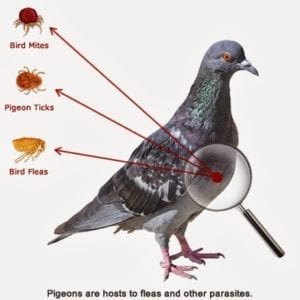
About Pigeon Patrol:
Pigeon Patrol Products & Services is the leading manufacturer and distributor of bird deterrent (control) products in Canada. Pigeon Patrol products have solved pest bird problems in industrial, commercial, and residential settings since 2000, by using safe and humane bird deterrents with only bird and animal friendly solutions. At Pigeon Patrol, we manufacture and offer a variety of bird deterrents, ranging from Ultra-flex Bird Spikes with UV protection, Bird Netting, 4-S Gel and the best Ultrasonic and audible sound devices on the market today.
Contact us at 1- 877– 4– NO-BIRD, (604) 585-9279 or visit our website at www.pigeonpatrol.ca
Bird Gone, Pigeon Gone, Seagull Gone, Pigeon problems, 1-877-4NO-BIRD, 4-S Gel, Bird Control, Pigeon Control, bird repellent,, sonic bird repellent, stainless steel , bird spikes Vancouver, Ultra Sonic Bird Control, Bird Netting, Canada bird deterrents, Pigeon Pests, B Gone Pigeon, Pigeon Patrol, pest controller, pest control operator, pest control technician, Pigeon Control Products, humane pigeon, pigeon deterrents, pigeon traps, Pigeon repellents, Sound & Laser Deterrents, wildlife control, raccoon, skunk, squirrel deterrent, De-Fence Spikes, Dragons Den, Canada bird spikes, Canada pigeon, pigeon control, pigeon patrol, pigeon. destroy pigeons, crow, starling, Pigeon Habitat, Pigeon identifications, pigeon myths
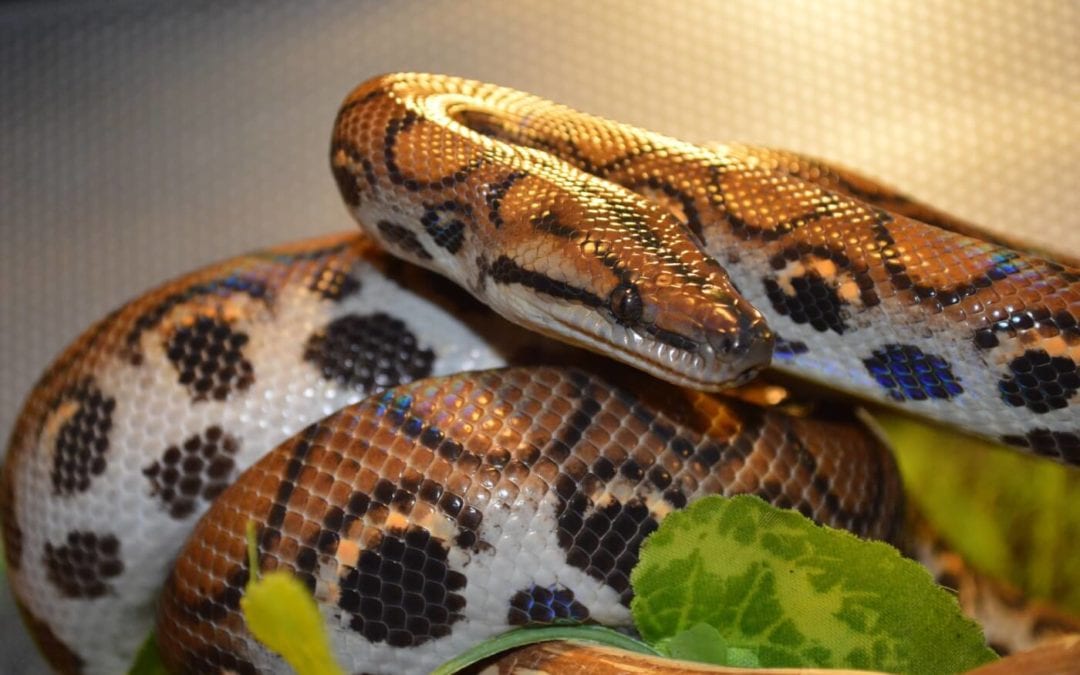
by Pigeon Patrol | Nov 5, 2020 | Pigeon Droppings, Pigeon Patrol's Services, Pigeon Predators, Pigeon Spikes
So you want to learn more about who and what are predators of the pigeon,
Well you’ve come to the right place. Today we will be talking about just that and how these pigeons try to avoid them.
Pigeon Predators
Some common predators of feral pigeons in North America are Foxes, snakes, red-tailed hawks, and owls. The birds that prey on pigeons in North America can range in size from American kestrels to golden eagles and can even include gulls, crows, and ravens.
Foxes are small to medium-sized, omnivorous mammals belonging to several genera of the family Canidae. Foxes have a flattened skull, upright triangular ears, a pointed, slightly upturned snout, and a long bushy tail. Twelve species belong to the monophyletic “true foxes” group of genus Vulpes. These animals can be seen preying on pigeons early in the morning
Snakes are no stranger to pigeons. Snakes are elongated, legless, carnivorous reptiles of the suborder Serpents. Like all other squamates, snakes are ectothermic, amniote vertebrates covered in overlapping scales. Snakes can easily swallow a pigeon in no time. There’s a couple of videos of snakes devouring pigeons.

Another big predator or the pigeon is the Seagull. Gulls, or colloquially seagulls, are seabirds of the family Laridae in the suborder Lari. They are most closely related to the terns and only distantly related to auks, skimmers and even more distantly to waders. Seagulls in Rome are “returning” to their natural status as predators, hunting down rats, pigeons, and other smaller birds as the lack of humans on the streets mean no food scraps are to be found

Another predator of pigeons are the golden eagle. The golden eagle is one of the best-known birds of prey in the Northern Hemisphere. It is the most widely distributed species of eagle. Like all eagles, it belongs to the family Accipitridae. These birds are dark brown, with lighter golden-brown plumage on their napes. The healthy adult golden eagle, due to its impressive size and hunting prowess, has no natural predators. Eggs, chicks, immature eagles, and injured birds are susceptible to a range of predators, such as other birds of prey, including other kinds of eagles and hawks, bears, wolves and cougars.
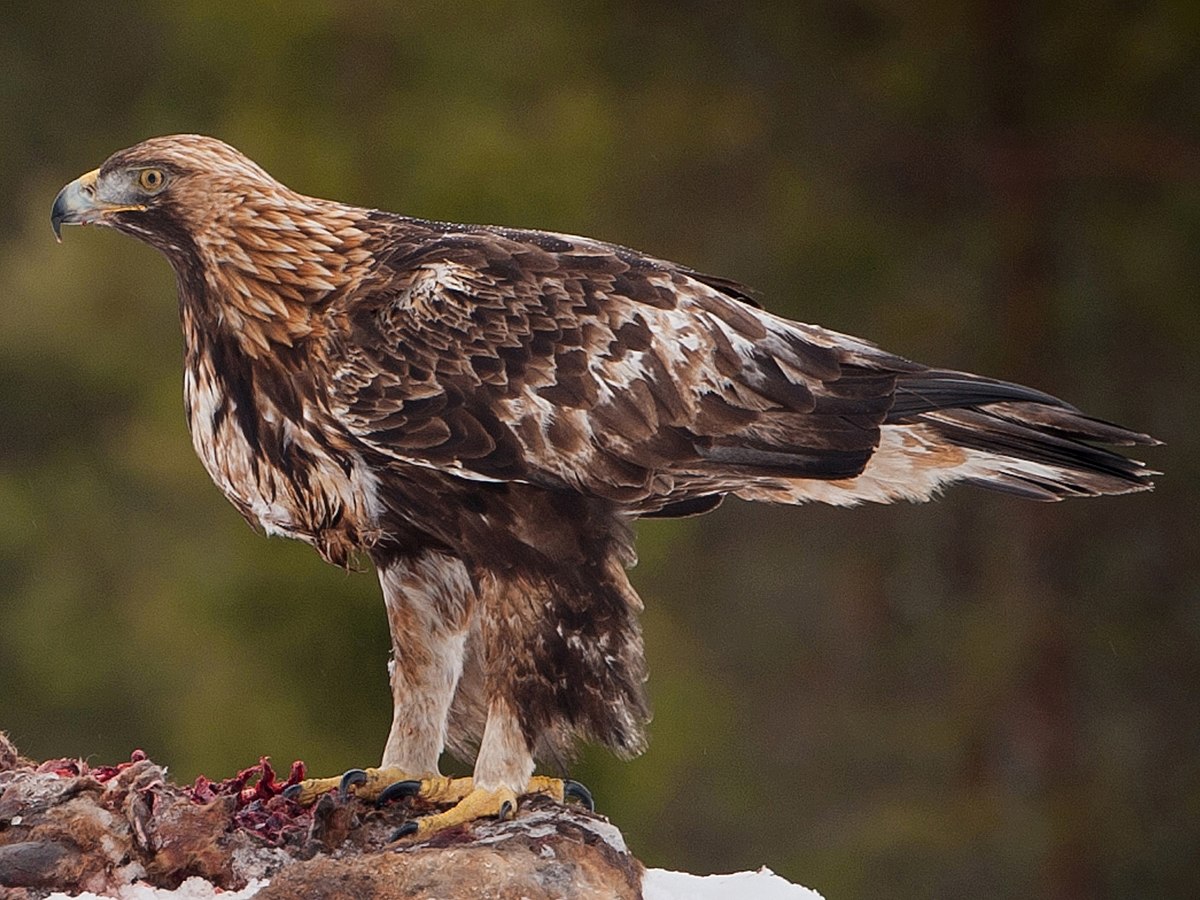
And the biggest predator of pigeons? Man is by far the greatest predator of pigeons.
How The Pigeon Avoid Predators
In most birds, flight is the most important means of escape from predators. Impaired flight abilities due to increased wing loading may increase vulnerability to predation. To compensate for an increase in wing loading, birds are able to independently decrease body mass (BM) or increase pectoral muscle mass (PMM). Comparing nearshore and farshore foraging shorebird species, we develop a theory as to which of these responses should be the most appropriate. We hypothesize that nearshore foragers should respond to increased predation by increasing their PMM in order to promote speed-based escape. Instead, farshore foragers should decrease BM in order to improve agility for maneuvering escape. Experiments on 2 shorebird species are consistent with these predictions, but on the basis of the theoretical framework for evaluating effect size and biological significance developed here, more experiments are clearly needed. Source
They can startle the predator, stand their ground, crouch and stay put, or fly off (Caro 2005). For most birds, flight is the predominant escape mode. A reduction of speed or maneuverability is likely to increase the chance of being depredated once airborne
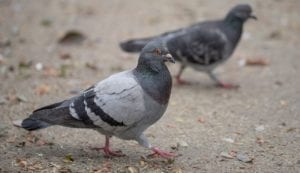
About Pigeon Patrol:
Pigeon Patrol Products & Services is the leading manufacturer and distributor of bird deterrent (control) products in Canada. Pigeon Patrol products have solved pest bird problems in industrial, commercial, and residential settings since 2000, by using safe and humane bird deterrents with only bird and animal friendly solutions. At Pigeon Patrol, we manufacture and offer a variety of bird deterrents, ranging from Ultra-flex Bird Spikes with UV protection, Bird Netting, 4-S Gel and the best Ultrasonic and audible sound devices on the market today.
Contact us at 1- 877– 4– NO-BIRD, (604) 585-9279 or visit our website at www.pigeonpatrol.ca
Bird Gone, Pigeon Gone, Seagull Gone, Pigeon problems, 1-877-4NO-BIRD, 4-S Gel, Bird Control, Pigeon Control, bird repellent,, sonic bird repellent, stainless steel , bird spikes Vancouver, Ultra Sonic Bird Control, Bird Netting, Canada bird deterrents, Pigeon Pests, B Gone Pigeon, Pigeon Patrol, pest controller, pest control operator, pest control technician, Pigeon Control Products, humane pigeon, pigeon deterrents, pigeon traps, Pigeon repellents, Sound & Laser Deterrents, wildlife control, raccoon, skunk, squirrel deterrent, De-Fence Spikes, Dragons Den, Canada bird spikes, Canada pigeon, pigeon control, pigeon patrol, pigeon. Kill pigeons, crow, starling, Pigeon Habitat, Pigeon identifications,
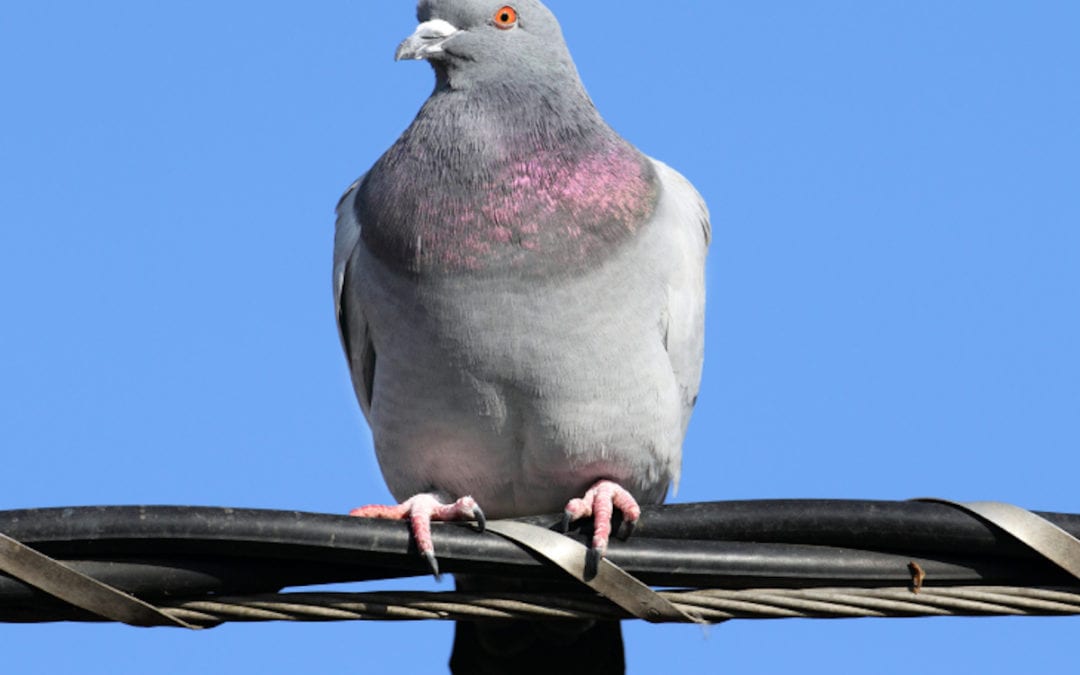
by Pigeon Patrol | Nov 4, 2020 | Animal Deterrent Products, Bird Deterrent Products, Bird Netting, Bird Spikes, Pigeon Control, Pigeon Droppings, Pigeon Patrol's Services
Do You Wanna Know How To Reduce The Numbers In Pigeons Roaming Around?
Keep on reading!
The need to reduce numbers in feral pigeon populations in urban areas has been the subject of intense debate for decades with town and city councils making little impact on the problem due to lack of investment and, in many cases, a reluctance to think laterally. Although the feral pigeon has been a common feature of urban life for the last 100 years there is no doubt that urban flocks are now growing faster than their numbers can be controlled. The reason for this unprecedented rise in feral pigeon numbers is due, almost exclusively, to the availability of food and the methods used to control the birds. Other factors such as the availability of good roosting and breeding facilities also play their part.
The feral pigeon is completely at home in urban environments, exploiting humans for food and using buildings for the purposes of roosting and breeding. This is because the feral pigeon is a descendent of the rock dove, a cliff-dwelling bird that was commonly found feeding and breeding along rocky coastlines prior to its mass exodus inland to make its home alongside man.

Pigeons (Rock Doves) in
their Natural Habitat
The reason that the rock dove chose to desert its natural habitat is the obvious availability of food combined with the optimum breeding and roosting potential offered by buildings, which resemble cliff faces. In its natural habitat the only real predator of the rock dove was the peregrine falcon, an extremely efficient predator that preyed on both pigeons and gull chicks.
In these natural environments flock size was restricted and maintained at levels dictated by the availability of natural food sources and the extent of predation in the area concerned. In urban environments, however, the picture is very different with man being the sole predator of the feral pigeon and food sources guaranteed.

Peregrine Falcon
Today the feral pigeon can be seen in virtually every area of the globe other than the two polar icecaps, exploiting man for food and his buildings for the purposes of roosting and breeding. Man has attempted to control the feral pigeon by using a variety of lethal controls, including poisons, narcotics, cage traps and shooting, and yet the pigeon has shrugged off all these attempts at population control and continued to live and breed in close association with man undeterred. Lethal controls have been complemented by an arsenal of deterrents, provided in an effort to deny or restrict roosting and perching opportunities (thereby reducing guano-related problems). Anti-roosting systems such as anti-roosting spikes have proved extremely effective at displacing pigeons from areas that pigeons roost and nest; but may not be a total solution as pigeons may simply move to other areas nearby.

Rifle Used for Pigeon Culling
So what other options are available to control and contain the problem? The answer to the question really lies in the source of the problem: available food and the means by which we currently control the birds. The use of lethal control as a means of controlling and reducing pigeon populations has been found to have no effect in terms of reducing pigeon flock size. Scientific research has even found that lethal controls can have the opposite effect, resulting in an increased flock size as a result of rejuvenation within the flock. Although we now have the science which proves that all attempts to reduce flock size by lethal means will be a wasted effort, the use of lethal control on pigeon populations is still extensive in the UK and many other countries worldwide. Why then are lethal controls used at all? Culling has been relied upon for decades by the pest control industry as a highly lucrative and revenue-rich service. If it were withdrawn as a control option many contractors would simply go out of business.

Pigeon Loft used for
Breeding Control
The only proven method of reducing pigeon flock size as part of an area-wide control system is to use a method pioneered by PiCAS International involving the use of artificial breeding facilities. This stand-alone method of control has been scientifically* proven to reduce pigeon flock size and is currently being employed throughout mainland Europe by councils and commercial organizations alike. The principle of a scheme using artificial breeding facilities is to provide a pigeon loft or dovecote in which feral pigeons can be encouraged to roost and breed and from which their eggs can be removed as laid and replaced with dummy eggs. This method of breeding control has been found to be extremely effective in reducing flock size and maintaining that reduction indefinitely
Whether a dovecote or pigeon loft is used the principle is the same – pigeons are encouraged to take up residence in the facility provided and as soon as breeding commences their eggs are removed as laid and substituted with dummy eggs. The hen bird will then continue to sit on the eggs for a period of between 18 and 25 days before realizing that the eggs will not hatch, at which time she will then abandon them. If eggs are removed without substituting with dummy eggs the hen bird will re-lay immediately and continue to re-lay each time her eggs are removed.
This may result in long-term health-related problems for the hen bird (such as a severe calcium deficiency) and as the goal is to maintain a small healthy flock of pigeons this is clearly not desirable.
The two types of artificial breeding facility available for use as a breeding control are very different in respect of both design and siting criteria, with a pigeon ‘loft’ normally provided on or possibly even within a building and a dovecote provided in an open space and at ground level. A pigeon loft would normally be provided by a property owner on a specific building or site in an effort to control breeding flocks of feral pigeons within that localized area. A dovecote would normally be provided in a green open space, such as a public park, where the scope of the facility would be the control of large feeding flocks of feral pigeons. In the case of a dovecote-based system a designated public feeding area would normally be provided adjacent to the dovecote in which the general public would be encouraged to feed pigeons, as the food would act to attract the birds to the dovecote facility.
The additional benefit of a designated feeding area, certainly where deliberate and persistent feeding of pigeons is identified as being the root cause of the problem, is that the facility will draw feeders away from their normal feeding areas in town and city centers and relocate them to green areas where pigeons can be better tolerated. Many councils will use the ‘carrot and stick’ approach when offering a system of this nature, providing feeders with legitimized areas in which to feed pigeons but large fines if they continue to feed outside the designated areas.
The main source of all pigeon-related problems in urban areas is deliberate and persistent over-feeding of pigeons by a small number of people who normally feed large quantities of high quality food 7 days a week. To a lesser extent the methods most commonly used to control pigeons (lethal controls) exacerbate and further entrench problems caused by overfeeding. The combination of overfeeding and the rejuvenation of pigeon flocks through the use of lethal controls has resulted in deeply entrenched problems in virtually every city in the Western world.
In some countries the feral pigeon has a religious significance and this fact has also acted to further embed the problem. Muslim, Hindu and Sikh cultures feed pigeons for religious reasons and although the feeding of pigeons for these reasons still continues in many UK towns and cities today, there is a view that the feeding of pigeons is the preserve of the older generation with younger generations taking little interest in the bird. In multi-racial cities like Leicester, for example, where the council embraces the concept of culling and where ethnic minority groups offer huge quantities of food to feral pigeon populations on a daily basis, feral pigeon flocks have grown to unsustainable proportions, creating deeply entrenched problems for property owners.

The problem has become so entrenched that several years ago PICAS International was called in to humanely remove nearly 2000 breeding pigeons and their young from 7 residential roof-spaces in council-owned properties in the city. This indicates the scale of the problem and confirms that citywide overfeeding of feral pigeons, combined with the over-use of culling, will only ever result in upwardly spiraling pigeon flock size.
For any urban pigeon control system to be effective there must not only be area-wide controls provided in the form of pigeon lofts and dovecotes with designated feeding areas, but also an acceptance by property owners that they must play their part. The only body that can be a catalyst for area-wide controls is a council, but if property owners fail to control pigeons on their own properties and allow entrenched roosting and breeding problems to occur or to continue any programme provided by the council will inevitably be compromised. Breeding controls can be astonishingly effective, but if property owners fail to exclude pigeons from their properties those same birds will continue to breed unchecked, further compounding the problem throughout the area. If breeding controls are provided in the form of lofts and dovecotes, however, and if both the local authority and property owners pull in the same direction, a vast majority of pigeons that are excluded during proofing programmes will end up in loft or dovecote facilities where their breeding can be controlled.
The average property owner can provide an extremely effective pigeon control system by installing deterrents in areas where roosting, breeding or perching exists and, if the problem justifies it, by providing an artificial breeding facility in the form of a pigeon loft. The combination of these two controls on one building or site will not only reduce the incidence of soiling in sensitive areas, but will also reduce flock size year on year, resulting in a small manageable flock of pigeons. This must be the goal of every property owner based on the fact that it is simply impossible to eradicate the feral pigeon completely. Although deterrents cannot be considered to be cheap, if the correct choice is made and if the product is sourced and installed by the property owner concerned at least 20-30 years’ protection should be afforded. The correct choice of deterrents is key, with some anti-perching products such as repellent gel only providing between 3 and 12 months’ protection and bird exclusion products like nylon bird netting only offering 5-10 years’ protection. The anti-roosting spike will, however, offer the property owner up to 30 years’ protection without the need to maintain or replace the product, making it an economical and aesthetically pleasing choice.
When a council chooses to provide an area-wide control system for feral pigeons (and very few UK-based councils do provide area-wide systems) expert guidance is critically important. Control systems that are designed to resolve entrenched pigeon-related problems are complex, particularly if the root cause of the problem is persistent and deliberate feeding by the general public. Many UK-based councils have attempted to address the problem by using hard-hitting and aggressive campaigns threatening pigeon feeders with large fines or imprisonment and often undertaking deeply unpopular culling operations at the same time. In each and every case these campaigns have failed due to the fact that the council concerned has failed to understand the underlying reason why people feed pigeons. The ‘problem’ cannot be dealt with as a littering offense or an anti-social act; it must be dealt with by education and persuasion rather than by threats and legislation.
If public feeding is identified to be the cause of the problem a system of controls must be provided that take the impact of persistent feeding into consideration at the same time as identifying large-scale pigeon roosts and closing them down. The principle of an effective area-wide control system using dovecote-based artificial breeding facilities is to provide the general public with an area specifically set aside for the purpose of pigeon feeding and to confirm that feeding is allowed in this area, but nowhere else.
A high-quality public education campaign must be launched confirming what the council is trying to achieve and why. Once a dovecote and designated feeding area facility has been provided in a central and accessible area the task of encouraging the feral pigeon population to feed on the site and take up residence in the dovecote is the next step.
Where pigeon-related problems exist as a result of public feeding the public education campaign will guide feeders to use the dovecote site for this purpose and as a result pigeons will follow, thereby resolving problems for property owners. Where breeding or roosting-related problems exist, however, it will be necessary to exclude pigeons from these areas with physical deterrents or to provide a loft-based artificial breeding facility or a combination of both.
One of the main reasons that area-wide control systems break down is the failure of councils to identify large-scale overnight roosts and force property owners to close them down and exclude pigeons. Councils have the power to force any property owner to undertake works to exclude pigeons from their property or, if the property owner refuses, to undertake those works itself and then bill the property owner. Even in light of these far-ranging powers, however, councils are deeply reluctant to take this action even though it may make render the area-wide control system a failure.
Of course, it is not always advisable or desirable to exclude pigeons from an existing roosting or breeding site, particularly if there is no area-wide control system in place to provide alternative accommodation. This does not stop property owners and companies like Network Rail excluding tens of thousands of pigeons from buildings and roosting sites under railway bridges every year. These excluded birds simply become someone else’s problem and the cycle begins again. This is why it is so important to provide a system of sustainable controls, such as the use of artificial breeding facilities, that will continue to control both breeding and (in the case of dovecote-based systems) feeding indefinitely, with little or no cost involved other than the initial outlay. These systems are popular with the general public and property owners alike as they humanely relocate pigeons to areas where they can be tolerated, accommodated and controlled without the need to resort to unpopular, invasive and unsustainable controls such as culling.
About Pigeon Patrol:
Pigeon Patrol Products & Services is the leading manufacturer and distributor of bird deterrent (control) products in Canada. Pigeon Patrol products have solved pest bird problems in industrial, commercial, and residential settings since 2000, by using safe and humane bird deterrents with only bird and animal friendly solutions. At Pigeon Patrol, we manufacture and offer a variety of bird deterrents, ranging from Ultra-flex Bird Spikes with UV protection, Bird Netting, 4-S Gel and the best Ultrasonic and audible sound devices on the market today.
Contact us at 1- 877– 4– NO-BIRD, (604) 585-9279 or visit our website at www.pigeonpatrol.ca
Bird Gone, Pigeon Gone, Seagull Gone, Pigeon problems, 1-877-4NO-BIRD, 4-S Gel, Bird Control, Pigeon Control, bird repellent,, sonic bird repellent, stainless steel , bird spikes Vancouver, Ultra Sonic Bird Control, Bird Netting, Canada bird deterrents, Pigeon Pests, B Gone Pigeon, Pigeon Patrol, pest controller, pest control operator, pest control technician, Pigeon Control Products, humane pigeon, pigeon deterrents, pigeon traps, Pigeon repellents, Sound & Laser Deterrents, wildlife control, raccoon, skunk, squirrel deterrent, De-Fence Spikes, Dragons Den, Canada bird spikes, Canada pigeon, pigeon control, pigeon patrol, pigeon. Kill pigeons, crow, starling, Pigeon Habitat, Pigeon identifications, reducing pigeons
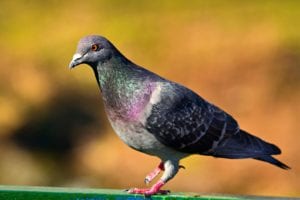
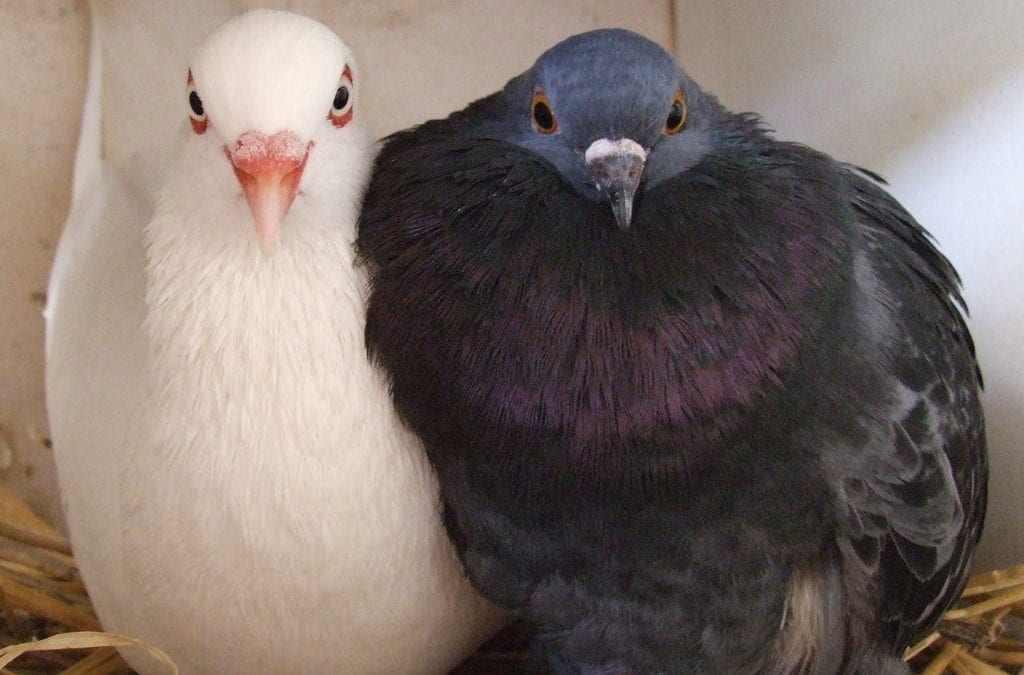
by Pigeon Patrol | Nov 4, 2020 | Columbidae, Doves, Pigeon Control, Pigeons, Pigeons in the News
Looking to learn the differences between pigeons and doves?
Well, look no further, because you’re in the right place!
In this blog you’ll learn:
- Size and Appearance of Doves and Pigeons
- Are Doves and Pigeons Considered Pests?
- Cultural Significance of Doves and Pigeons
- Pest Control for Pigeons
- FAQ
What Are Their Differences In Size And Appearance?
Doves and pigeons are both members of the family of birds known as Columbidae. They are similar in many respects, but there are still some noticeable differences between them.
Doves
Doves are smaller than pigeons. Some weigh as little as 22 grams (less than an ounce). The most noticeable aspect about them is their pointed tail.
The most plentiful breed of doves in America is the mourning dove or rain dove. They typically range in size around 12-inches in length and weigh between 4 and 6 ounces.
The head is rounded with a distinctive crescent-shaped area of dark feathers under each eye. They are a light grayish-brown color with lighter, pink coloration underneath, and a dark speckling on their wings.
They are strong fliers, capable of reaching speeds up to 55 mph. At takeoff and landing their wings make an unusual whistling sound, a phenomena known as sonation, the deliberate production of sounds without using the throat or vocal cords.
The adult males have some bright purple-pink patches on the sides of their neck, along with light pink coloring reaching the breast. On the crown of their head is distinctly bluish-grey in color.
The female, by contrast, is a bit smaller than the males and instead of the male’s bright plumage have more brown coloration overall.
Doves eat seeds almost exclusively and prefer open or semi-open habitats such as prairies, grasslands, and lightly wooded areas while avoiding swamps and thick forests.
They are generally monogamous and both parents participate in feeding and caring for their young. After a noisy courtship flight, the male will lead the female to several potential nesting sites in various trees until she chooses one, then helps her build the nest.
She normally lays two eggs and one or the other of them always remains with the eggs, then later with the young until they’re mature.
Doves will put on a broken-wing display in order to distract a predator who is approaching the nest and their young. They do this by fluttering about on the ground as if they’re helpless or injured, then flying away when the predator gets close.
Pigeons
Pigeons are larger than doves and have a rounded tail instead of a pointed one. They are usually 13-inches or more in length and can weigh as much as 4kg (8.8 pounds).
The most common variety of pigeons are the rock pigeons. They’re usually light gray on their upper body and belly, with a darker gray on their head and breast.
They can be identified by the distinctive iridescent purple and green coloration on their neck and breast. They’re not native to the United States. They were introduced into America from Europe in the 1600’s. This means they have no natural predators to limit their population.
Homing pigeons were selectively bred from rock pigeons to take advantage of their innate ability to find their way home over incredibly long distances. This ability is believed to be a function of magnetoreception, the ability to use the earth’s magnetic field to navigate.
Their long-distance flight speed (over distances of 400 miles) has been clocked at 50 mph sustained speed, but they can go as high as 90 mph in racing contests.
Rock pigeons have been domesticated for thousands of years, as food and as message carriers. The males are usually larger than the females and stand taller.
They have larger beaks, with eye cores (fleshy growth around the eyes), round heads and thick napes. Females, however, are shorter with smaller beaks and ceres. They have flatter heads and larger breasts than the males.
Courtship rituals are noisy. The male will puff out his chest, strut around the female bobbing his head and cooing insistently.
He will often turn completely around during his display. Once the female accepts him, they mate for life and will often re-enact their courtship over and over throughout their lives.
Pigeons are quite content to nest on building ledges, rooftops, girders, and the rafters of warehouses. They eat seeds almost exclusively and will take turns foraging when they have young in their nest.
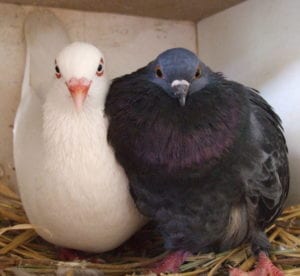
Source
Are Doves and Pigeons Considered Pests?
Yes & No.
Doves aren’t considered pests. They generally don’t nest in and around human habitations, although they have been known to do so occasionally.
For the most part, they are considered a game bird and sportsmen enjoy a good dove hunt as much as hunting for turkeys, pheasants, or any other wild game.
When it comes to pigeons, however, the situation is a bit different. Factories often have quite extensive problems with them nesting in the rafters of warehouses or the upper stories of a power plant.
It doesn’t take long before their population expands to the point where they become a genuine nuisance.
Their droppings discolor machinery, stairways, railings, pallets, crates, and anything else (or anyone else) unfortunate enough to be under when they “let go.” It leaves a pungent, unpleasant odor and the biochemicals in it can accelerate the deterioration of whatever it touches.
What Is The Cultural Significance of Doves and Pigeons?
Doves
For most of human history, doves have been considered symbols of peace. The iconic symbol of a dove carrying an olive branch in its mouth had its beginnings in the early chapters of the Book of Genesis in the Bible.
And he waited yet another seven days, and again he sent the dove out from the ark. Then the dove came to him in the evening, and behold, a freshly plucked olive leaf was in her mouth; and Noah knew that the waters had receded from the earth. [Genesis 8:10-11, NKJV]After the rain stopped, Noah sent out a dove but it came back. The next time he sent it out it came back carrying an olive branch in its beak, a symbol that God’s wrath – and the waters of the Flood – was abating, and peace was returning to the world.
The New Testament also has a dove that symbolizes peace and love. When Jesus went down to the Jordan river to be baptized by John, He came up out of the water and the Holy Spirit, in the shape of a dove, came down upon Him.
When He had been baptized, Jesus came up immediately from the water; and behold, the heavens were opened to Him, and He saw the Spirit of God descending like a dove and alighting upon Him. And suddenly a voice came from heaven, saying, “This is My beloved Son, in whom I am well pleased.” [Matthew 3:16-17, NKJV]That powerful imagery from these two events has stayed with us ever since and has been used in peace movements all over the world even by those who reject the Biblical story of the Flood and Jesus.
There is even a book entitled Doves and Diplomats that is dedicated to the subject.
Pigeons
Despite their many similarities, pigeons occupy a somewhat lower position in the, ahem, pecking order, than doves do. There are Mesopotamian cuneiform tablets that are over 5000 years old showing pigeons being domesticated and raised for food.
They have also been used in commerce, and by the military, to carry important messages back and forth. Early references to pigeons being used to carry messages date back to 2500 B.C.
The Roman Empire used pigeons for this purpose, as did the ancient Greeks. Whereas doves are seen more like symbols, pigeons are more often viewed as work animals or food.
Pigeons have often been housed in structures referred to as dovecotes, essentially a hen house for pigeons. These birdhouses ranged from crude, thatch-covered huts to clay pot-shaped buildings to ornate structures designed to hold thousands of birds.
Pigeons were domesticated not only for food and for its ability to “return home” but also for sport.
Pigeon racing has a long and storied history, as do various forms of falconry and pigeon killing. With the advent of guns, sports shooting of pigeons quickly gained popularity.
Huge numbers of pigeons would be captured, then released all at once in front of a crowd of hunters who shot them at point-blank range.
“Clay pigeons” were derived from this practice when the availability of live pigeons dwindled through over-hunting.
How Can You Control Pigeons?
Doves don’t provide nearly the nuisance level of activity that their larger pigeon cousins do, so this section will focus mainly on pigeons.
As stated earlier, they have a regrettable habit of infesting factories and large buildings then pooping all over them, producing an unsightly mess and a health hazard.
One of the ways PCO’s (Pest Control Operators) defend against pigeons is with the use of anti-bird spikes. Many of them are actually called pigeon control spikes, which tells you how often they’re the culprit in these situations.
These spikes can be laid out on girders and ledges where pigeons like to nest. They can’t land without getting stabbed or hurting their feet so they eventually give up and fly away somewhere else.
A second way PCO’s control pigeon populations is through live trapping. Bird traps are set out with bait corn in them and the doors wired open so they won’t close.
After the pigeons get used the traps and get used to going in and out without harm, then the PCO unwires the doors and lets the traps capture the pigeons. Once the trap is full the PCO collects the birds and transports them away for release back into the wild.
The problem here is obvious; pigeons, with their natural homing ability, quickly return to their “home” in the factory or warehouse and you’re right back to square one.

The only permanent solution is to kill them with poisoned bait. The PCO does essentially the same thing as before with the live trapping, only this time without a trap.
Unpoisoned bait is put out for a week or so to acclimate the birds to being feed at a certain place. Once they’re feeding freely on the safe bait, the poisoned bait is substituted and the pigeons will go on eating it as usual. Very quickly they’ll all be dead.
Frequently Asked Questions
Is it safe to ship doves across the country for a wedding release?
Yes. Dove release companies do this all the time without any danger to the birds. Once released, the birds immediately fly back home again.
What should I do if I find an injured dove or pigeon?
As with any wild animal that is injured, be careful not to let them bite or scratch you. They’re in scared and in pain.
They won’t understand that you’re trying to help them and will fight to escape. Contact a local veterinarian for help on capturing the bird.
Is it okay to feed pigeons and doves?
Yes and no. It’s not illegal to feed them, but you’ll definitely be encouraging them to gather for a daily feeding, which increases the amount of bird poop in the area.
They can also get quite noisy when they’re squabbling over food, which might upset your neighbors. It might not be against the law to feed them, but it might be against good manners.
What should I feed pigeons and doves?
Birdseed for doves and pigeons is available in 6-25 pound bags. Rather than putting it in a bird feeder as people do with smaller birds, spread it out across your backyard.
If you feed them at the same time every day it won’t be long before they’ll be out there waiting for you when it’s time.
About Pigeon Patrol:
Pigeon Patrol Products & Services is the leading manufacturer and distributor of bird deterrent (control) products in Canada. Pigeon Patrol products have solved pest bird problems in industrial, commercial, and residential settings since 2000, by using safe and humane bird deterrents with only bird and animal friendly solutions. At Pigeon Patrol, we manufacture and offer a variety of bird deterrents, ranging from Ultra-flex Bird Spikes with UV protection, Bird Netting, 4-S Gel and the best Ultrasonic and audible sound devices on the market today.
Contact us at 1- 877– 4– NO-BIRD, (604) 585-9279 or visit our website at www.pigeonpatrol.ca
Bird Gone, Pigeon Gone, Seagull Gone, Pigeon problems, 1-877-4NO-BIRD, 4-S Gel, Bird Control, Pigeon Control, bird repellent,, sonic bird repellent, stainless steel , bird spikes Vancouver, Ultra Sonic Bird Control, Bird Netting, Canada bird deterrents, Pigeon Pests, B Gone Pigeon, Pigeon Patrol, pest controller, pest control operator, pest control technician, Pigeon Control Products, humane pigeon, pigeon deterrents, pigeon traps, Pigeon repellents, Sound & Laser Deterrents, wildlife control, raccoon, skunk, squirrel deterrent, De-Fence Spikes, Dragons Den, Canada bird spikes, Canada pigeon, pigeon control, pigeon patrol, pigeon. Kill pigeons, crow, starling, Pigeon Habitat, Pigeon identifications,
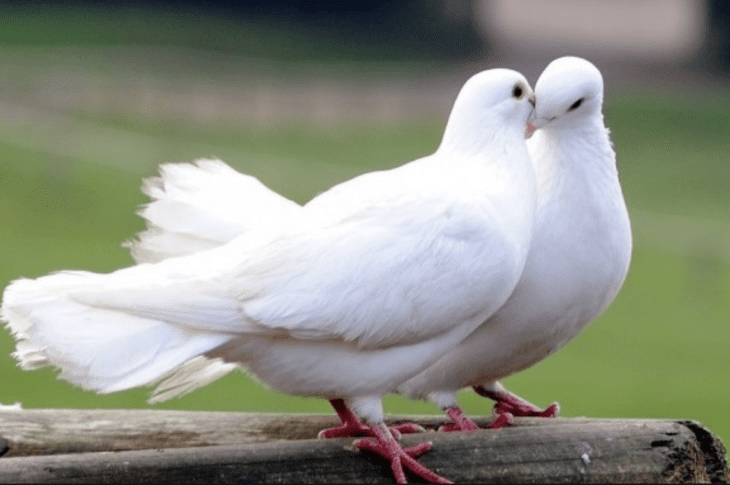
by Pigeon Patrol | Nov 4, 2020 | Columbidae, Doves
What Do Doves Eat
Pigeons and doves eat a variety of grains, seeds, greens, berries, fruits, and will occasionally eat insects, snails and earthworms in the wild.
General Information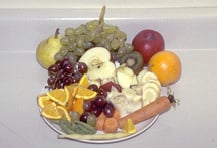
Our knowledge of bird nutrition is constantly evolving. This is due both to heightened awareness of the importance of nutrition and to increased research into birds different needs. As with all other animals, birds need a proper balance of carbohydrates, proteins, fat, vitamins, minerals and water. Different species of birds often require different foods.
Should I be concerned about what my doves eat?
Nutrition is commonly neglected with pet birds. You should discuss the nutrition of your pet pigeon or dove with your veterinarian! Too often owners assume they are feeding a proper diet to their pigeon or dove when in fact they are not! This is a common reason for many health problems. It is important to continually strive to improve your bird’s diet. This involves constantly educating yourself and a certain degree of common sense. It is not sufficient to feed a pigeon or dove just to maintain life; instead, your goal should be to help it thrive and flourish. Your bird’s health depends on how well it is fed.
What does my dove naturally eat?
Pigeons and doves eat a variety of grains, seeds, greens, berries, fruits, and will occasionally eat insects, snails and earthworms in the wild.
What should I feed them?
- A well balanced diet must be maintained at all times. Consult your veterinarian if encountering any problems with diet or the health of the bird.
Seeds
Formulated pigeon seed diets are available. A commercial diet contains mixed seeds and grains, vegetables and some are enriched with brewer’s yeast plus vitamins and minerals. Different diet formulations exist for performance birds, resting birds and breeding birds.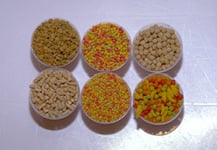
Pigeons are susceptible to calcium deficiency from eating only seeds. Seeds should only be 50% of a balanced diet, never the entire diet.
“Different diet formulations exist for performance birds, resting birds and breeding birds.”
Pelleted Diets
“Pellets should ideally represent approximately 50% of a pigeon’s diet.”
Pellets have been developed to meet all your bird’s nutritional needs. Hand raised babies are the easiest to start on a pelleted diet. Pellets are the ideal diet, therefore you are encouraged to slowly wean seed eating birds onto a pelleted diet. Pellets should ideally represent approximately 50% of a pigeon’s diet. There are many good brands of pelleted foods in the market place.
Fruits and Vegetables
Finely chopped vegetables and greens plus some fruit should be offered as part of the daily diet. Pale vegetables, with a high water composition (i.e. iceberg or head lettuce, celery) offer very little nutritional value. Avocado is reported to be potentially toxic.
Fruits and vegetables must be washed thoroughly to remove chemicals. Cut them into manageable pieces depending on the size of the bird. It is not necessary to take the skin off. Offer fruits and vegetables in a separate dish. If your bird appears to develop a particular fancy for one food item, reduce its volume or stop feeding it temporarily to promote the eating of other foods.
Treat your bird like a small child; offer a small piece of a variety of food items daily and never stop trying. A well balanced diet must be maintained at all times.
Water
Fresh clean water must be available at all times. Depending on the quality of your tap water, you might consider the use of bottled water. Dishes must be cleaned thoroughly every day with soap and water.
Will my bird have any different needs throughout its life?
Birds that are extremely young, stressed, injured, laying eggs or raising young may have certain special requirements. There are specially formulated pelleted foods available for birds with specific nutritional requirements. Consult your veterinarian regarding these situations.
Does my pigeon or dove need extra vitamins, minerals or amino acids?
Your veterinarian can help you assess your bird’s diet and its particular needs. One expert suggests that a pigeon eating 50% of its diet in the form of pelleted food may not need supplements. Specific vitamins or minerals may be more important at various times during a pigeon or dove’s life (e.g., calcium supplements during egg laying)). Calcium supplements are available if your pigeon is determined to be deficient.
“Mix these products in water or preferably apply directly onto moist food.”
Powdered supplements, such as Nekton® (by Nekton-Produkte), Quiko® or Prime® (by Hagen), are often regarded as more stable. Mix these products in water or preferably apply directly onto moist food. Placing these powders on seeds or dried foods is of little value since it will ultimately end up on the bottom of the food dish and not in the bird.
Does my Dove need gravel or grit?
Controversy exists over the need for gravel. It was believed that grit was necessary for the mechanical breakdown of food in the gizzard as an aid to digestion. Birds seem to do fine without grit. Most pigeons are offered a small amount of grit, crushed eggshell or oyster shell. Some birds will in fact have problems if grit is over eaten.
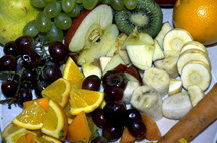 What pointers should I remember about feeding my Dove?
What pointers should I remember about feeding my Dove?
- Always monitor the amount of food eaten every day by each bird.
- Offer fresh water every day.
- Offer a variety of fresh foods every day.
- Offer fresh fruits and vegetables every day
- Clean all food and water dishes daily.
- No to a food item one day does not mean no forever – KEEP TRYING!
Other Items Your Doves Should Eat:
- Fruits like Apples, Bananas, Pears, Cherries, Peaches, Blueberries
- Vegetables like Bok Choy, Peppers, Lettuce, Cabbage, Carrots, Brussel Sprouts, Potato
Source
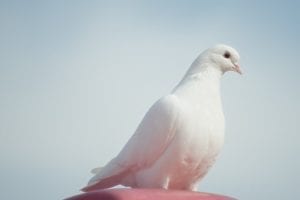
About Pigeon Patrol:
Pigeon Patrol Products & Services is the leading manufacturer and distributor of bird deterrent (control) products in Canada. Pigeon Patrol products have solved pest bird problems in industrial, commercial, and residential settings since 2000, by using safe and humane bird deterrents with only bird and animal friendly solutions. At Pigeon Patrol, we manufacture and offer a variety of bird deterrents, ranging from Ultra-flex Bird Spikes with UV protection, Bird Netting, 4-S Gel and the best Ultrasonic and audible sound devices on the market today.
Contact us at 1- 877– 4– NO-BIRD, (604) 585-9279 or visit our website at www.pigeonpatrol.ca
Bird Gone, Pigeon Gone, Seagull Gone, Pigeon problems, 1-877-4NO-BIRD, 4-S Gel, Bird Control, Pigeon Control, bird repellent,, sonic bird repellent, stainless steel , bird spikes Vancouver, Ultra Sonic Bird Control, Bird Netting, Canada bird deterrents, Pigeon Pests, B Gone Pigeon, Pigeon Patrol, pest controller, pest control operator, pest control technician, Pigeon Control Products, humane pigeon, pigeon deterrents, pigeon traps, Pigeon repellents, Sound & Laser Deterrents, wildlife control, raccoon, skunk, squirrel deterrent, De-Fence Spikes, Dragons Den, Canada bird spikes, Canada pigeon, pigeon control, pigeon patrol, pigeon. Kill pigeons, crow, starling, Pigeon Habitat, Pigeon identifications,
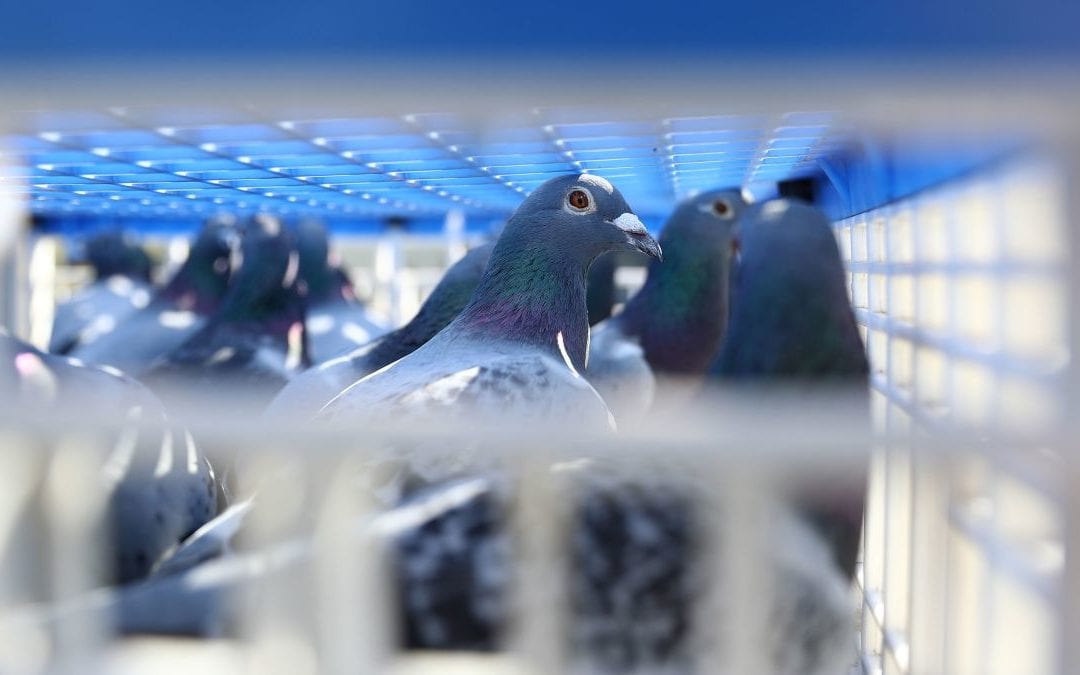
by Pigeon Patrol | Nov 2, 2020 | Animal Deterrent Products, Bird Deterrent Products, history of pigeons, Pigeon Control, Pigeon Patrol's Services
Feral pigeons are the number one urban pest bird, creating a mess and causing damage where they roost, creating a need for pigeon control. Pigeons are descendants of domesticated European homing pigeons, so they have a varied diet and feel at ease making their homes in man-made structures, here is some of the pigeon identifications.
Generally blue-grey in color, with iridescent feathers on the head and neck, problem pigeons often have markings in black, white or brown on the wings and neck. A short neck and small head characterize the standard pigeon; their short legs, hind toes and level front allow for both easy perching on pipes and ledges or walking on flat surfaces. Pigeons generally nest in small, flat areas away from the ground such as building ledges, air conditioning units or window sills. Occasionally pigeons may even lay eggs directly on a protected ledge.
Damage Caused by Pigeon Problems
Pigeon control is important due to the damage and disease problems these problem birds often create. The uric acid in pigeon feces is highly corrosive and can cause extensive damage to metals and other substrates it sits on for long periods. Debris from flocks of problem pigeons often build up, backing up gutters and drains which can cause flooding and roof damage.
Nesting materials and other debris has caused failures in machinery, especially rooftop air conditioning units which are a prime nesting spot for pigeons. Other frequent pigeon problems include slip and fall liability from feces or debris, plus an unclean, dirty company image. The bacteria, fungal agents and ectoparasites found in pigeon droppings are responsible for a host of serious diseases, including histoplasmosis, encephalitis, salmonella, meningitis, toxoplasmosis and more. Many companies also retain significant clean up costs due to the pigeon problems they don’t resolve.
Source
About Pigeon Patrol:
Pigeon Patrol Products & Services is the leading manufacturer and distributor of bird deterrent (control) products in Canada. Pigeon Patrol products have solved pest bird problems in industrial, commercial, and residential settings since 2000, by using safe and humane bird deterrents with only bird and animal friendly solutions. At Pigeon Patrol, we manufacture and offer a variety of bird deterrents, ranging from Ultra-flex Bird Spikes with UV protection, Bird Netting, 4-S Gel and the best Ultrasonic and audible sound devices on the market today.
Contact us at 1- 877– 4– NO-BIRD, (604) 585-9279 or visit our website at www.pigeonpatrol.ca
Bird Gone, Pigeon Gone, Seagull Gone, Pigeon problems, pigeon spikes, 1-877-4NO-BIRD, 4-S Gel, Bird Control, Pigeon Control, bird repellent, Bird Spikes, sonic bird repellent, stainless steel bird spikes, bird spikes Vancouver, Ultra Sonic Bird Control, Bird Netting, Plastic Bird Spikes, Canada bird spike deterrents, Pigeon Pests, B Gone Pigeon, Pigeon Patrol, pest controller, pest control operator, pest control technician, Pigeon Control Products, humane pigeon spikes, pigeon deterrents, pigeon traps, Pigeon repellents, Sound & Laser Deterrents, wildlife control, raccoon, skunk, squirrel deterrent, De-Fence Spikes, Dragons Den, Canada bird spikes, Canada pigeon, pigeon control, pidgon patrol, pidgon. Kill pigeons, crow, starling, Pigeon Habitat, pigeon identifications
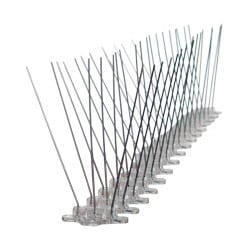
by Pigeon Patrol | Nov 2, 2020 | Animal Deterrent Products, Bird Deterrent Products, Bird Spike, Pigeon Patrol's Services, Pigeon Spikes
Why You Should Use Bird Spikes
You have a bird problem and want to get rid of them. Pigeon Patrol has got you covered with our Bird Spikes. Why? Keep on reading to find out why you should use bird spikes.
What
A bird control spike, is an object consisting of long, needle-like rods used for bird control. They come in a variety of styles and sizes but they work in the same way. Bird control spikes can be attached to building ledges, street lighting, roofs, commercial signage & anywhere else birds can possibly land on to prevent wild or feral birds from perching or roosting.
Why
These spikes make it difficult if not impossible for the bird to land or walk in the area with spikes. They will bring to harm to the bird but will make them uncomfortable that they will have to leave the area. These spikes have glue tracks and screw holes, the spikes can safely be attached to almost any surface. Source
Pigeon Patrol
At Pigeon Patrol, we offer stainless steel bird spikes. Steel spikes offer unique benefits. Not only are they less visible and blend in with a building’s architecture better than plastic spikes, steel spikes also come with a longer guarantee and are able to withstand direct sunlight and higher temperatures Ultra-flex Bird Spikes, prevents birds from landing or roosting on rooftops, ledges, and other surfaces. It comes in either a 5 inch or 8 inch spread and is virtually invisible when installed. The spikes come in 2-foot lengths and measures 4½ inches in height.
- Base made with UV protected recyclable polycarbonate.
- Spikes made with stainless steel,
4½ inches in height.
- Ultra flexible for pipes, beams, signs and light poles.”
- Install with screws, caulking or cable ties
- Spikes come in 2 ft sections with a 10-year warranty
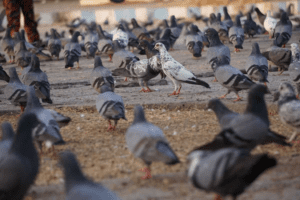
Contact Us For Any Questions!
(604) 585-9279
About Pigeon Patrol:
Pigeon Patrol Products & Services is the leading manufacturer and distributor of bird deterrent (control) products in Canada. Pigeon Patrol products have solved pest bird problems in industrial, commercial, and residential settings since 2000, by using safe and humane bird deterrents with only bird and animal friendly solutions. At Pigeon Patrol, we manufacture and offer a variety of bird deterrents, ranging from Ultra-flex Bird Spikes with UV protection, Bird Netting, 4-S Gel and the best Ultrasonic and audible sound devices on the market today.
Contact us at 1- 877– 4– NO-BIRD, (604) 585-9279 or visit our website at www.pigeonpatrol.ca
Bird Gone, Pigeon Gone, Seagull Gone, Pigeon problems, 1-877-4NO-BIRD, 4-S Gel, Bird Control, Pigeon Control, bird repellent,, sonic bird repellent, stainless steel , bird spikes Vancouver, Ultra Sonic Bird Control, Bird Netting, Canada bird deterrents, Pigeon Pests, B Gone Pigeon, Pigeon Patrol, pest controller, pest control operator, pest control technician, Pigeon Control Products, humane pigeon, pigeon deterrents, pigeon traps, Pigeon repellents, Sound & Laser Deterrents, wildlife control, raccoon, skunk, squirrel deterrent, De-Fence Spikes, Dragons Den, Canada bird spikes, Canada pigeon, pigeon control, pigeon patrol, pigeon. Kill pigeons, crow, starling, Pigeon Habitat, Pigeon identifications,
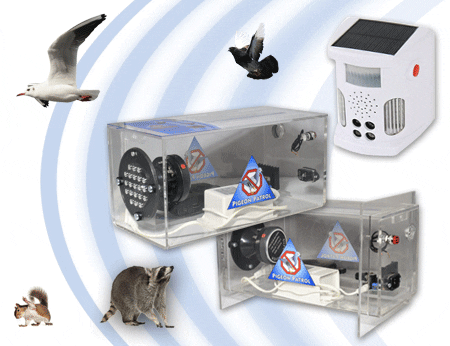
by Pigeon Patrol | Nov 2, 2020 | Animal Deterrent Products, Bird Deterrent Products
What Is It?
Well, What is a UltraSonic Pest Repeller? They are electronic devices that emit high-frequency sounds designed to deter birds, rodents and insects away from your property. Pigeon Patrol has made our own device where the sound is too high pitched for people to hear, but audible to birds. This has the advantage to preventing disturbance to neighboring households. Our device will not a disturbance to house pets such as cats and dogs
How It Works
The ultrasonic devices are placed where you need it the most which may be your balcony or patio which then purportedly emit high-frequency sounds that are disruptive to pests. The sound supposedly causes a physiological response known as audiogenic seizure response, which is characterized by non-directional running, convulsions, and possibly death from cerebral hemorrhage. The theory behind the devices is that confused rodents eventually flee when the disruption prevents them from gathering food, breeding, building nests or communicating. Ultrasonic devices are popular and appealing to consumers because of their ease of use and the fact that they are silent to human ears and allegedly eliminate the need for traps and poison, which are thought by some to be inhumane forms of pest control. Electromagnetic and subsonic devices are also available, and all designs vary by signal intensity, rate and frequency. source
Distress call or sound emitters consist of a central unit and Tweeter. the system emits the distress calls, or calls of predators of the target species. Effective emitters randomize the type of call, time interval and magnitude to prevent birds’ from getting used to the sound.
Contact Us For Any Questions!
(604) 585-9279
About Pigeon Patrol:
Pigeon Patrol Products & Services is the leading manufacturer and distributor of bird deterrent (control) products in Canada. Pigeon Patrol products have solved pest bird problems in industrial, commercial, and residential settings since 2000, by using safe and humane bird deterrents with only bird and animal friendly solutions. At Pigeon Patrol, we manufacture and offer a variety of bird deterrents, ranging from Ultra-flex Bird Spikes with UV protection, Bird Netting, 4-S Gel and the best Ultrasonic and audible sound devices on the market today.
Contact us at 1- 877– 4– NO-BIRD, (604) 585-9279 or visit our website at www.pigeonpatrol.ca
Bird Gone, Pigeon Gone, Seagull Gone, Pigeon problems, pigeon spikes, 1-877-4NO-BIRD, 4-S Gel, Bird Control, Pigeon Control, bird repellent, Bird Spikes, sonic bird repellent, stainless steel bird spikes, bird spikes Vancouver, Ultra Sonic Bird Control, Bird Netting, Plastic Bird Spikes, Canada bird spike deterrents, Pigeon Pests, B Gone Pigeon, Pigeon Patrol, pest controller, pest control operator, pest control technician, Pigeon Control Products, humane pigeon spikes, pigeon deterrents, pigeon traps, Pigeon repellents, Sound & Laser Deterrents, wildlife control, raccoon, skunk, squirrel deterrent, De-Fence Spikes, Dragons Den, Canada bird spikes, Canada pigeon, pigeon control, pigeon patrol, pigeon. Kill pigeons, crow, starling, Pigeon Habitat, Pigeon identifications, Pigeon Spikes, Ultrasonic Pest Repellers
The post What’s The Deal With UltraSonic Pest Repellers? appeared first on Pigeon Patrol Canada – Bird Control Products & Services.
Filed Under: Animal Deterrent Products, Bird Deterrent Products, Pigeon Patrol’s Services, Pigeons in the News, UltraSonic Bird Control
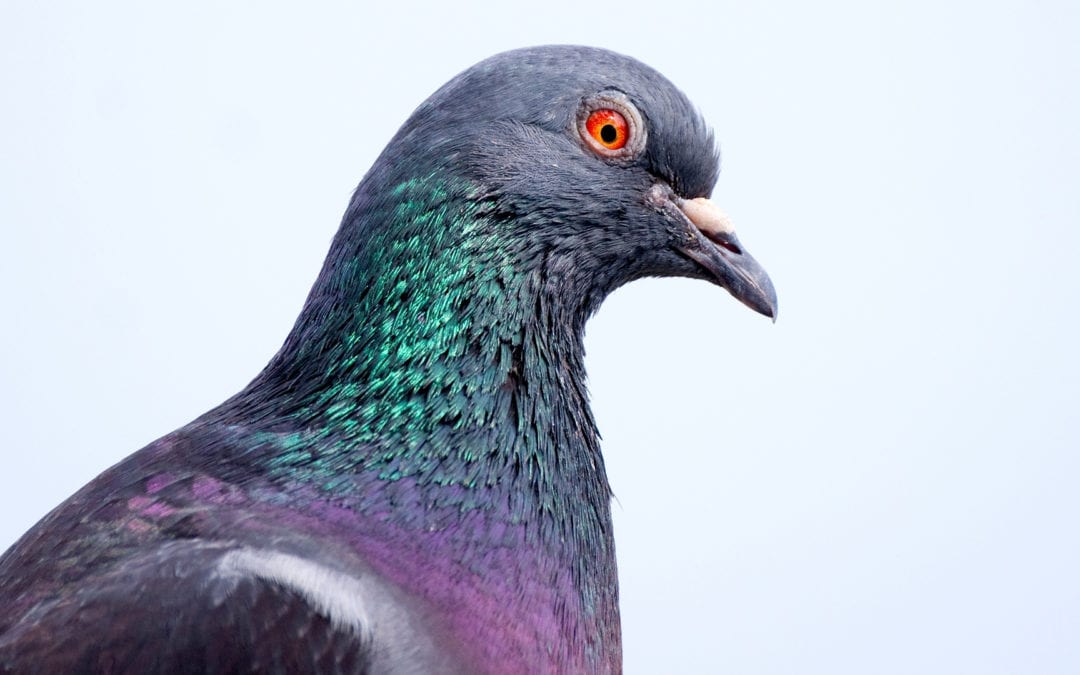
by Pigeon Patrol | Nov 2, 2020 | Pigeon Control, Pigeon Patrol's Services
Pigeon Prevention Methods & Damage Control
Habitat Modification
Some solutions include elimination of feeding, watering, roosting, and nesting sites is important in long-term pigeon control. Discourage people from feeding pigeons in public areas and clean up spilled grain around elevators, feed mills, and rail-car clean-out areas. Eliminate pools of standing water that pigeons use for watering. Modify structures, buildings, and architectural designs to make them less attractive to pigeons.
Exclusion
Pigeons can be excluded from buildings by blocking access to indoor roosts and nesting areas. Openings to lofts, steeples, vents, and eaves should be blocked with wood, metal, glass, rust-proofed wire mesh, plastic or nylon netting with spikes surround it.
Roosting on ledges can be discouraged by changing the angle to 45o or more. Sheet metal, wood, styrofoam blocks, stone, and other materials can be formed and fastened to ledges to accomplish the desired angle. Ornamental architecture can be screened with 1-inch (2.5-cm) mesh polypropylene u.v.-stabilized netting to prevent roosting, loafing, and nesting. To make the netting aesthetically pleasing, it can be spray painted to match the color of the building, but black is often the best choice. The life span of this netting can be as long as 10 years.
In a tool or machinery shed, barn, hangar, or other similar buildings, roosting can be permanently prevented by screening the underside of the rafter area with netting. Nylon netting can be stapled or otherwise affixed to the underside of rafters to exclude birds from nesting and roosting. Panels can be cut into the netting and velcro fasteners can allow access to the rafter area to service equipment or lights.
Porcupine wires are mechanical repellents that can be used to exclude pigeons. They are composed of a myriad of spring-tempered nickel stainless steel prongs with sharp points extending outward at all angles. The sharp points of these wires inflict temporary discomfort and deter pigeons from landing on these surfaces. The prongs are fastened to a solid base that can be installed on window sills, ledges, eaves, roof peaks, ornamental architecture, or wherever pigeons are prone to roost (Fig. 2). Elevate the base with plastic washers and anchor it with electrical bundle straps. Sometimes pigeons and sparrows cover the wires with nesting material or droppings, which requires occasional removal.
A variation of porcupine wires, ECOPICTM, mounts flat to a surface and has a triangular pattern of vertically oriented stainless steel rods.
Bird BarrierTM is another permanent nonlethal mechanical repellent used to exclude pigeons from structures. It is a stainless steel coil affixed to a base-mounting strip that can be attached to structural features as one would with porcupine wires.
Tightly stretched parallel strands of 16-to 18-gauge steel wire or 80-pound+ (36-kg+) test monofilament line can be used to keep birds off support cables, narrow ledges, conduit, and similar areas. Attach L-brackets at each end of the area or item to be protected and fasten the wire to the L-brackets with turnbuckles. Slack is taken out using the turnbuckles. L-brackets should be welded or attached with a cable clamp or aircraft hose clamps (threads on standard radiator clamps become stripped under the high torque loads required for holding L-brackets sup-porting wire over long distances). On heavily used structures, it may be necessary to stretch 3 lines at 2, 5, and 7 inches (5, 12, and 18 cm) above the surface.
Overhead monofilament grid systems, 1 x 1 foot to 2 x 2 feet (30 x 30 cm to 60 x 60 cm), have been used success-fully to reducing pigeon activity in en-closed courtyards. Persistent pigeons will likely penetrate parallel or grid-wire (line) systems.
Electric shock bird control systems (Avi-AwayTM, FlyawayTM, and Vertebrate Repellent System [VRSTM]) are available for repelling many species of birds, including pigeons. The systems consist of a cable durably embedded in plastic with two electrical conductors. Mounting and grounding hardware and a control unit are included. The conductors carry a pulsating electric charge. When pigeons make contact with the conductors and the cable, they receive a shock that repels but does not kill them. The cable can be in-stalled in situations also suitable for porcupine wires and stretched steel wires or monofilament lines. Although these devices and their installation are usually labor intensive and/or expensive, their effectiveness in some cases justifies the investment. These devices have a life span of 8 years on residential structures.
other control methods include:
Frightening
- Propane cannons
- Distress calls
- Mylar-style tape
- Scare-eye balloons
- Long-range acoustic devices
- Avitrol®
Repellents
- Polybutenes and capsaicin-based products
- Methyl anthranilate
Toxicants
Shooting
- .177-caliber pellet guns
- .22-caliber rifles
- Shotgun with No. 7½ shot
Trapping
- Multiple capture cage traps
- Single-bird traps
- Cannon nets
- Hand-held nets
- Mist netting
Other Control Methods
Source
Contact Us For Any Questions!
(604) 585-9279
About Pigeon Patrol:
Pigeon Patrol Products & Services is the leading manufacturer and distributor of bird deterrent (control) products in Canada. Pigeon Patrol products have solved pest bird problems in industrial, commercial, and residential settings since 2000, by using safe and humane bird deterrents with only bird and animal friendly solutions. At Pigeon Patrol, we manufacture and offer a variety of bird deterrents, ranging from Ultra-flex Bird Spikes with UV protection, Bird Netting, 4-S Gel and the best Ultrasonic and audible sound devices on the market today.
Contact us at 1- 877– 4– NO-BIRD, (604) 585-9279 or visit our website at www.pigeonpatrol.ca
Bird Gone, Pigeon Gone, Seagull Gone, Pigeon prevention methodsPigeon problems, pigeon spikes, 1-877-4NO-BIRD, 4-S Gel, Bird Control, Pigeon Control, bird repellent, Bird Spikes, sonic bird repellent, stainless steel bird spikes, bird spikes Vancouver, Ultra Sonic Bird Control, Bird Netting, Plastic Bird Spikes, Canada bird spike deterrents, Pigeon Pests, B Gone Pigeon, Pigeon Patrol, pest controller, pest control operator, pest control technician, Pigeon Control Products, humane pigeon spikes, pigeon deterrents, pigeon traps, Pigeon repellents, Sound & Laser Deterrents, wildlife control, raccoon, skunk, squirrel deterrent, De-Fence Spikes, Canada bird spikes, Canada pigeon, pigeon control, pigeon patrol, pigeon. Kill pigeons, crow, starling, Pigeon Habitat, Pigeon identifications, Pigeon Spikes, Ultrasonic Pest Repellers, Pest Control, Bird Spike Installation, Netting Installation, Pigeon Prevention Methods & Damage Control, Bird netting,
The post Pigeon Prevention Methods & Damage Control appeared first on Pigeon Patrol Canada – Bird Control Products & Services.
Filed Under: 4-S Gel Bird repellent, Animal Deterrent Products, Bird Deterrent Products, Bird Netting, Pigeon Patrol’s Services, Pigeon Spikes, UltraSonic Bird Control

by Pigeon Patrol | Nov 2, 2020 | history of pigeons
Where Are They Found?
The history of these pigeons were originally found wild in Europe, North Africa, and Western Asia, pigeons have become established in cities around the world. The species is abundant, with an estimated population of 17 to 28 million feral and wild birds in Europe alone and up to 120 million worldwide. These birds were introduced into North America in the early 1600’s. Window ledges and tall buildings mimic the rocky cliffs originally inhabited by their ancient ancestors in Europe. The pigeon has a long history of association with humans, having been used for food and entertainment for over 5,000 years. Source
How Many Species Are There?
Pigeons live worldwide except in the coldest regions and the most remote islands. About 250 species are known; two-thirds of them occur in tropical Southeast Asia, Australia, and the islands of the western Pacific, but the family also has many members in Africa and South America and a few in temperate Eurasia and North America. All members of the family suck liquids, rather than sip and swallow as do other birds, and all pigeon parents feed their young “pigeon’s milk,” the sloughed-off lining of the crop, the production of which is stimulated by the hormone prolactin. The nestling obtains this “milk” by poking its bill down the parent’s throat.
Pigeons are gentle, plump, small-billed birds with a skin saddle (cere) between the bill and forehead. All pigeons strut about with a characteristic bobbing of the head. Because of their long wings and powerful flight muscles, they are strong, swift fliers. Pigeons are monogamous; i.e., they mate for life, and the survivor accepts a new mate only slowly. The female lays two glossy white eggs in a flimsy nest that barely holds them. The female generally incubates the eggs by night, the male by day. The incubation period is 14 to 19 days, but the young are cared for in the nest for another 12 to 18 days. Source
Contact Us For Any Questions!
(604) 585-9279
About Pigeon Patrol:
Pigeon Patrol Products & Services is the leading manufacturer and distributor of bird deterrent (control) products in Canada. Pigeon Patrol products have solved pest bird problems in industrial, commercial, and residential settings since 2000, by using safe and humane bird deterrents with only bird and animal friendly solutions. At Pigeon Patrol, we manufacture and offer a variety of bird deterrents, ranging from Ultra-flex Bird Spikes with UV protection, Bird Netting, 4-S Gel and the best Ultrasonic and audible sound devices on the market today.
Contact us at 1- 877– 4– NO-BIRD, (604) 585-9279 or visit our website at www.pigeonpatrol.ca
Bird Gone, Pigeon Gone, Seagull Gone, Pigeon problems, pigeon spikes, 1-877-4NO-BIRD, 4-S Gel, Bird Control, Pigeon Control, bird repellent, Bird Spikes, sonic bird repellent, stainless steel bird spikes, bird spikes Vancouver, Ultra Sonic Bird Control, Bird Netting, Plastic Bird Spikes, Canada bird spike deterrents, Pigeon Pests, B Gone Pigeon, Pigeon Patrol, pest controller, pest control operator, pest control technician, Pigeon Control Products, humane pigeon spikes, History of pigeons, pigeon deterrents, pigeon traps, Pigeon repellents, Sound & Laser Deterrents, wildlife control, raccoon, skunk, squirrel deterrent, De-Fence Spikes, Dragons Den, Canada bird spikes, Canada pigeon, pigeon control, pigeon patrol, pigeon. Kill pigeons, crow, starling, Pigeon Habitat, Pigeon identifications, Pigeon Spikes, Ultrasonic Pest Repellers
The post History of Pigeons appeared first on Pigeon Patrol Canada – Bird Control Products & Services.
Filed Under: Pigeon Patrol’s Services
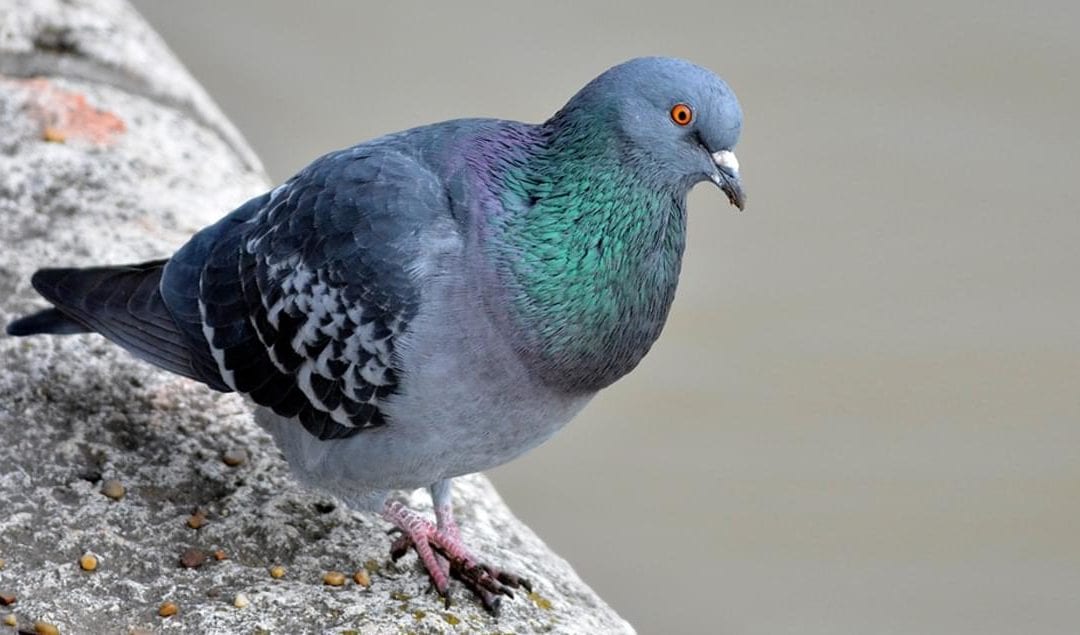
by Pigeon Patrol | Oct 26, 2020 | Animal Deterrent Products, Bird Deterrent Products, Bird Netting, Bird Spikes, Pigeon Control, Pigeon Spikes
What To Do With Annoying Pigeons
When pigeon flocks grow too large, use these humane methods to control their numbers
From a pigeon’s perspective, city living can’t be beat. Food and water are readily available. Predators are rare. Plus, there’s plenty of free housing. Pigeons find our window ledges, rooftops, bridges, and warehouses to be ideal substitutes for the natural ledges in cliff sides that they have always used as roosting, nesting, and sheltering sites.
Steps to Solve Pigeon Problems
You may just need one or a combination of all techniques, depending on the size of the pigeon population you’re dealing with.
Spikes & Nettings
The bird spike is a simple device used to prevent birds from perching or roosting on flat surfaces. Spike systems consist of thin, mildly flexible rods set in a base in multiple rows at varying angles. Pigeon spikes are not sharp and will not harm birds in any way; pigeon spikes are always dull and are completely safe and humane. Contact with the spikes is uncomfortable but never painful or dangerous. The sole purpose of the spikes is to block the birds’ feet from reaching the flat surface; without a foothold, the birds can’t roost. You can use bird spikes to protect your property with a clear conscience.
Bird control spikes are easy to understand, install, and maintain. No special tools are needed, no complicated assembly is involved, and making certain that the spikes don’t become clogged with leaves or other debris is the only maintenance required. In addition, no other bird control device is as cost-effective when measured in money and time; anti-bird spikes don’t require costly installation upfront and continue to function for a long, long time. Bird spikes are honestly a great way to keep birds away.
Anti-bird spikes offer the following advantages:
They Are Safe
Impaling birds is not the purpose of the spikes. Bird spikes have harmless, dull tips, and the spikes themselves are just a bit bendy. When birds try to land, they get a gentle, uncomfortable prod in their undercarriage, and their feet are unable to reach the surface.
Effective
Many bird control experts agree that bird spikes are 100% effective at deterring roosting birds when installed correctly. Spikes work by preventing birds from roosting, and they work every time. Rain or shine, day or night, today, tomorrow, and next year, spikes keep birds away.
Long Lifetime
Bird control spikes offer low-maintenance protection for years. High-quality strips and spikes are constructed to withstand constant exposure to harsh, changing weather conditions.
Unobstructive
Strips don’t cause any interference with electrical or communication transmissions, and, especially from a distance, they won’t significantly interfere with the look of your property. The only thing you will notice is the absence of birds.
Easy To Use
Spikes come preassembled in 2-foot strips that are notched for a tool-free breakdown. A piped line of adhesive down the bottom of the strip gives you a quick and permanent installation, or, for temporary installation, strips can be nailed, screwed, or even zip-tied down. Plus, anyone can do it; installing bird spikes is well within the skills of any competent DIYer.
Stop Feeding The Pigeons (intentionally or not)
Most conflicts with pigeons can be tied at one point or another to feeding, intentionally or otherwise.
Pigeons get fed plenty of handouts and garbage, but there are also well-intentioned pigeon lovers who regularly feed the birds. This does the pigeons more harm than good as the pigeons begin to gather in large numbers, often leading to inhumane and ineffective attempts to reduce their numbers.
When such troubles arise, the best thing for the birds is to reduce feeding gradually over several weeks. The flock will gradually disperse until the remaining number of birds matches what the area can naturally support.
Unintentional Food Sources
Even when not feeding on purpose, we humans are messy, leaving leftovers and dropped crumbs everywhere. Pigeons hang around town squares, public parks, and other trafficked areas to help themselves to what we leave behind, especially when convenient roosting and nesting sites are nearby. To discourage pigeons from gathering, food attractants need to be cleaned up regularly.
In suburban neighborhoods, too, homeowners may mistakenly feed pigeons or they may be providing food for pigeons inadvertently when feeding their backyard birds by tossing seed on the ground, rather than putting it in birdfeeders. To discourage pigeons visiting your yard, change the type, amount, and timing of feeding. If most of the pigeons fail to move elsewhere, you’ll need to stop feeding all birds for a couple weeks. (Don’t worry; the birds won’t starve.) When you resume feeding, only put out seed in birdfeeders and keep the ground below them cleaned up.
Prevent Roosting and Nesting
Pigeons look for flat surfaces for roosting and nesting. Encourage them to do these things elsewhere by making flat surfaces unavailable to them. With the correct application of the right product, roosting structures can be rendered virtually pigeon-free.
Follow these tips and steps to get rid of the annoying pigeons
source
About Pigeon Patrol:
Pigeon Patrol Products & Services is the leading manufacturer and distributor of bird deterrent (control) products in Canada. Pigeon Patrol products have solved pest bird problems in industrial, commercial, and residential settings since 2000, by using safe and humane bird deterrents with only bird and animal friendly solutions. At Pigeon Patrol, we manufacture and offer a variety of bird deterrents, ranging from Ultra-flex Bird Spikes with UV protection, Bird Netting, 4-S Gel and the best Ultrasonic and audible sound devices on the market today.
Contact us at 1- 877– 4– NO-BIRD, (604) 585-9279 or visit our website at www.pigeonpatrol.ca
Bird Gone, Pigeon Gone, Seagull Gone, Pigeon problems, pigeon spikes, 1-877-4NO-BIRD, 4-S Gel, Bird Control, Pigeon Control, bird repellent, Bird Spikes, bird law sonic bird repellent, stainless steel bird spikes, bird spikes Vancouver, Ultra Sonic Bird Control, Bird Netting, Plastic Bird Spikes, Canada bird spike deterrents, Pigeon Pests, B Gone Pigeon, annoying pigeons, Pigeon Patrol, annoying pigeons pigeon family pest controller, pest control operator, Bird law pest control technician, Pigeon Control Products, humane pigeon spikes,pigeon droppings pigeon deterrents, type of birds, pigeon traps, Pigeon repellents, Sound & Laser Deterrents, wildlife control, raccoon, skunk, squirrel deterrent, De-Fence Spikes, Dragons Den, Canada bird spikes, Pigeon behavior ,Canada pigeon, pigeon control, pigeon patrol, pigeon. Kill pigeons, crow, starling, Pigeon Habitat, annoying pigeons
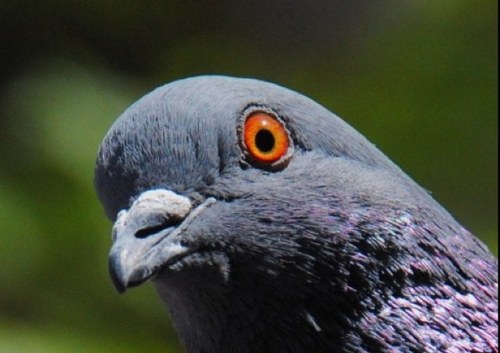
 people to slip and fall, which makes it especially important to rid the birds from highly trafficked areas. Source
people to slip and fall, which makes it especially important to rid the birds from highly trafficked areas. Source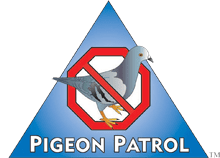























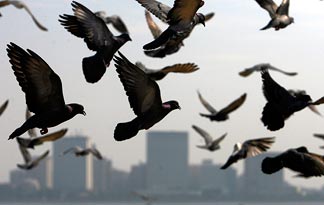







 Pigeons (Rock Doves) in
Pigeons (Rock Doves) in Peregrine Falcon
Peregrine Falcon
 Rifle Used for Pigeon Culling
Rifle Used for Pigeon Culling










 What pointers should I remember about feeding my Dove?
What pointers should I remember about feeding my Dove?







